Table of Contents
- Introduction
- Editor’s Choice
- Sun Protection Industry Statistics
- Global Sun Protection Skin Care Industry Statistics
- Sunscreen Cream Industry Statistics
- Sun Protection Users and Penetration Statistics
- Sunscreen Product Usage Frequency
- Most Used SPF Types
- Age Dynamics
- Gender Dynamics
- Sunscreen Product Price Statistics
- Consumer Preferences and Trends
- Sunscreen Benefits
- Challenges and Concerns
- Innovations in Sunscreen Protection Technology
- Regulations for Sunscreen Products
- Recent Developments
- Conclusion
- FAQs
Introduction
Sunscreen Industry Statistics: Sunscreen is essential for protecting the skin from the harmful effects of UV radiation. Which includes UVA rays that contribute to skin aging and wrinkles and UVB rays that cause sunburn and increase skin cancer risk.
Sunscreens can be chemical, absorbing UV rays and converting them into heat, or physical, using minerals like zinc oxide to block UV rays.
SPF measures protection against UVB rays, with SPF 30 to 50 being generally recommended. Broad-spectrum sunscreens offer protection from both UVA and UVB rays, while water-resistant options remain effective during water exposure.
For optimal protection, sunscreen is usually applied 15 to 30 minutes before sun exposure. Reapplied every two hours, and chosen based on skin type and sensitivity.
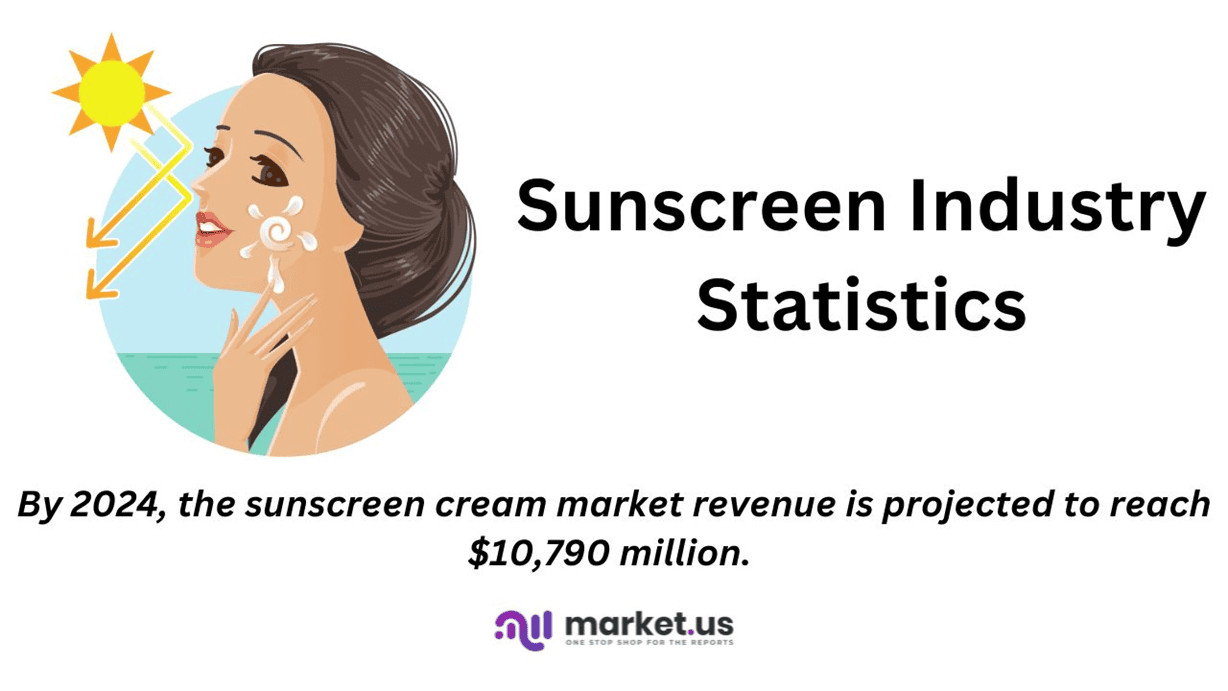
Editor’s Choice
- The revenue of the global sun protection skin care industry is projected to reach $13,553.78 million by 2028.
- In 2023, the revenue generated from the sun protection skincare market varied significantly across different countries. The United States led with a substantial revenue of $1,983 million, followed by China with $1,075 million.
- By 2024, the sunscreen cream market revenue is projected to reach $10,790 million.
- In 2018, the distribution of sunscreen users in Peru varied notably across different age groups. The highest percentage of users was found in the 35-44 years age group, which accounted for 23.10% of the respondents.
- In April 2023, the interest in sun protection-related content among Chinese consumers showed a clear distribution across different age groups. The highest interest was observed in the youngest demographic. With 33.90% of respondents aged 24 years and younger engaging with sun protection content.
- In France, in 2022, consumers considered various factors when purchasing sunscreen. With effectiveness of protection being the paramount concern for 45% of respondents. Emphasizing the primary function of sunscreen in safeguarding against sun damage.
- In 2022, U.S. consumers showed varied opinions regarding the potential toxicity of traditional sunscreens to their health. A minority of 20% believed that traditional sunscreens could be toxic. Indicating concerns about the ingredients commonly used in these products.
Sun Protection Industry Statistics
Global Sun Protection Market Size Statistics
- The global sun protection market has experienced consistent growth from 2017 to 2029.
- In 2017, the market was valued at $1.55 billion, which increased to $1.79 billion in 2018 and further to $2.05 billion in 2019.
- The growth continued to accelerate, reaching $2.53 billion in 2020 and significantly rising to $3.26 billion in 2021.
- There was a slight decrease in 2022 to $3.14 billion, but it rebounded to $3.24 billion in 2023.
- The upward trend persisted, with the market size expanding to $3.57 billion in 2024, $4.00 billion in 2025, and $4.43 billion in 2026.
- By 2027, the market value rose to $4.81 billion, followed by an increase to $5.12 billion in 2028, and it is projected to reach $5.34 billion by 2029.
- This progression underscores the growing global emphasis on sun protection and the corresponding expansion of market opportunities.
(Source: Statista)

Global Sun Protection Market Share – By Sales Channel Statistics
- The distribution of sales in the global sun protection market from 2017 to 2029 indicates a significant shift from offline to online channels.
- In 2017, offline channels dominated with 84.5% of sales, while online sales were just 15.5%.
- Over the years, the gap narrowed: by 2018, offline sales decreased to 81.3%, and online sales increased to 18.7%.
- This trend continued in 2019, with offline sales further declining to 78.8% and online sales increasing to 21.2%.
- A marked shift occurred in 2020 when offline sales dropped sharply to 67.2% and online surged to 32.8%.
- By 2021, the shift was even more pronounced, with offline sales at 60.2% and online sales nearing 40% at 39.8%.
- The years that followed saw a stabilization, though the trend towards online shopping persisted: in 2022, offline sales were at 67.6%, and online at 32.4%. Followed by a slight decline in offline sales in 2023 to 69.9% and online sales to 30.1%.
- By 2024, offline sales accounted for 68.8%, with online rising slightly to 31.2%.
- The pattern continued into 2029, where offline sales were projected to further reduce to 61.7% while online sales increased to 38.3%. Highlighting the increasing consumer preference for online shopping in the sun protection market.
(Source: Statista)
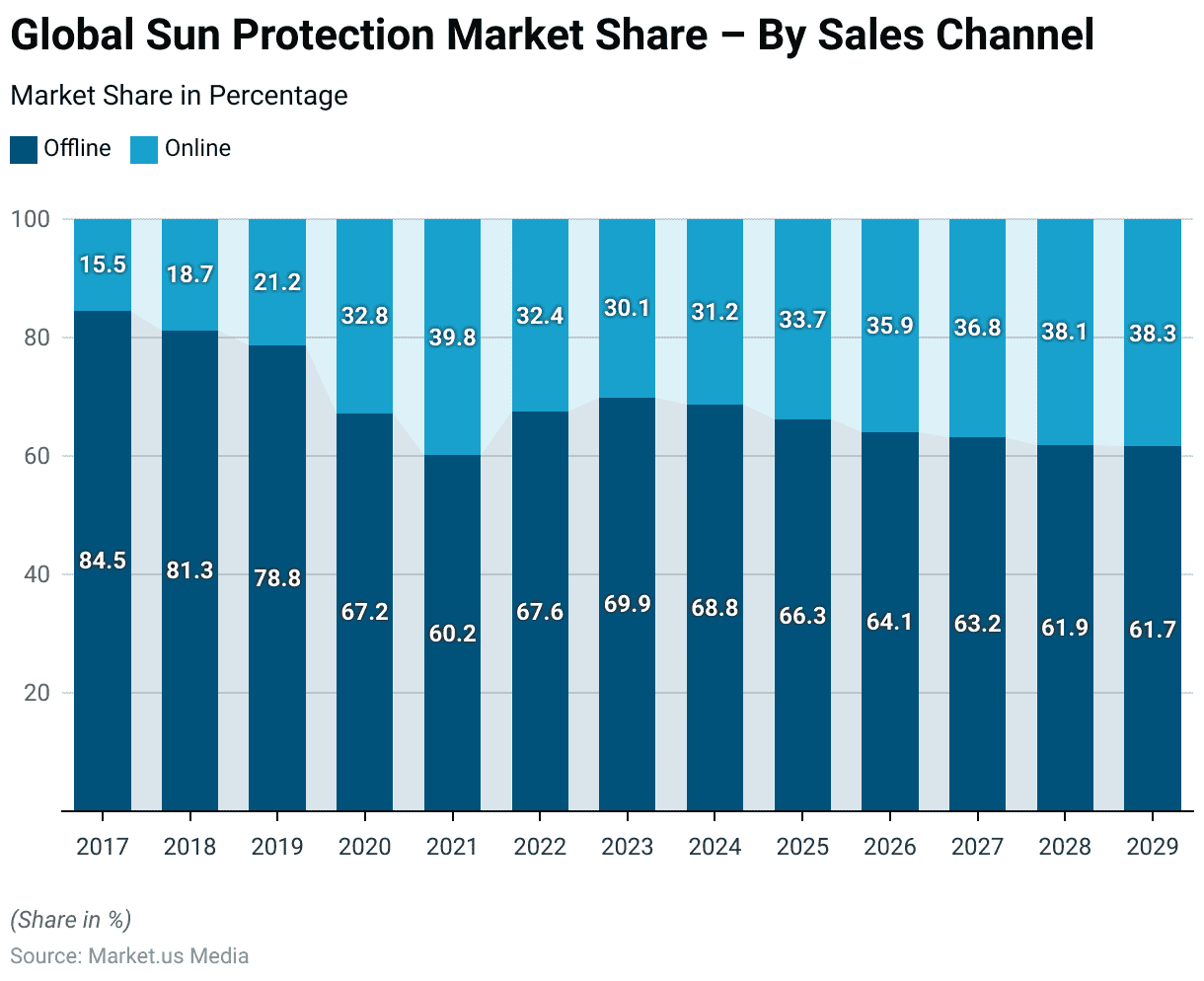
Sun Protection Market Revenue – By Country
- In terms of revenue by country within the sun protection market, significant variances are evident.
- The United States leads substantially with a revenue of $1,015 million.
- South Korea follows with a notable $331.90 million, while China contributes $260.70 million.
- Italy also has a strong market presence at $247.80 million, and the United Kingdom rounds out the top five at $228.60 million.
- France’s market revenue stands at $143.80 million. Followed by Spain with $106.70 million and Germany with $95.13 million.
- Russia and Indonesia contribute $87.85 million and $68.43 million, respectively.
- Further down the list, Canada generates $65.19 million, Australia $59.10 million, and Saudi Arabia $57.92 million.
- The Netherlands and India also participate in the market, with revenues of $51.71 million and $40.10 million, respectively.
- This distribution illustrates a diverse global interest and investment in sun protection products across various nations.
(Source: Statista)
Take advantage of our unbeatable offer - buy now!


Global Sun Protection Skin Care Industry Statistics
Global Sun Protection Skin Care Industry Revenue
- The revenue of the global sun protection skin care industry has demonstrated notable fluctuations and an overall upward trend from 2015 to 2028.
- In 2015, the industry generated $8,735.72 million, followed by a slight increase in 2016 to $8,841.87 million.
- The growth continued, reaching $9,275.65 million in 2017 and $9,663.23 million in 2018. The revenue slightly increased in 2019 to $9,758.20 million.
- A significant drop occurred in 2020, where revenue fell to $7,780.68 million, likely impacted by external factors.
- However, recovery was evident in 2021, with revenue rising to $8,280.82 million and further increasing in 2022 to $9,786.48 million.
- The upward trajectory continued into 2023, with revenue jumping to $10,828.78 million.
- Projections indicate continued growth with expected revenues of $11,517.45 million in 2024, $11,953.32 million in 2025, $12,469.86 million in 2026, $13,199.95 million in 2027, and reaching $13,553.78 million by 2028.
- This data highlights the resilience and expanding market potential of the sun protection skincare industry over the examined period.
(Source: Statista)
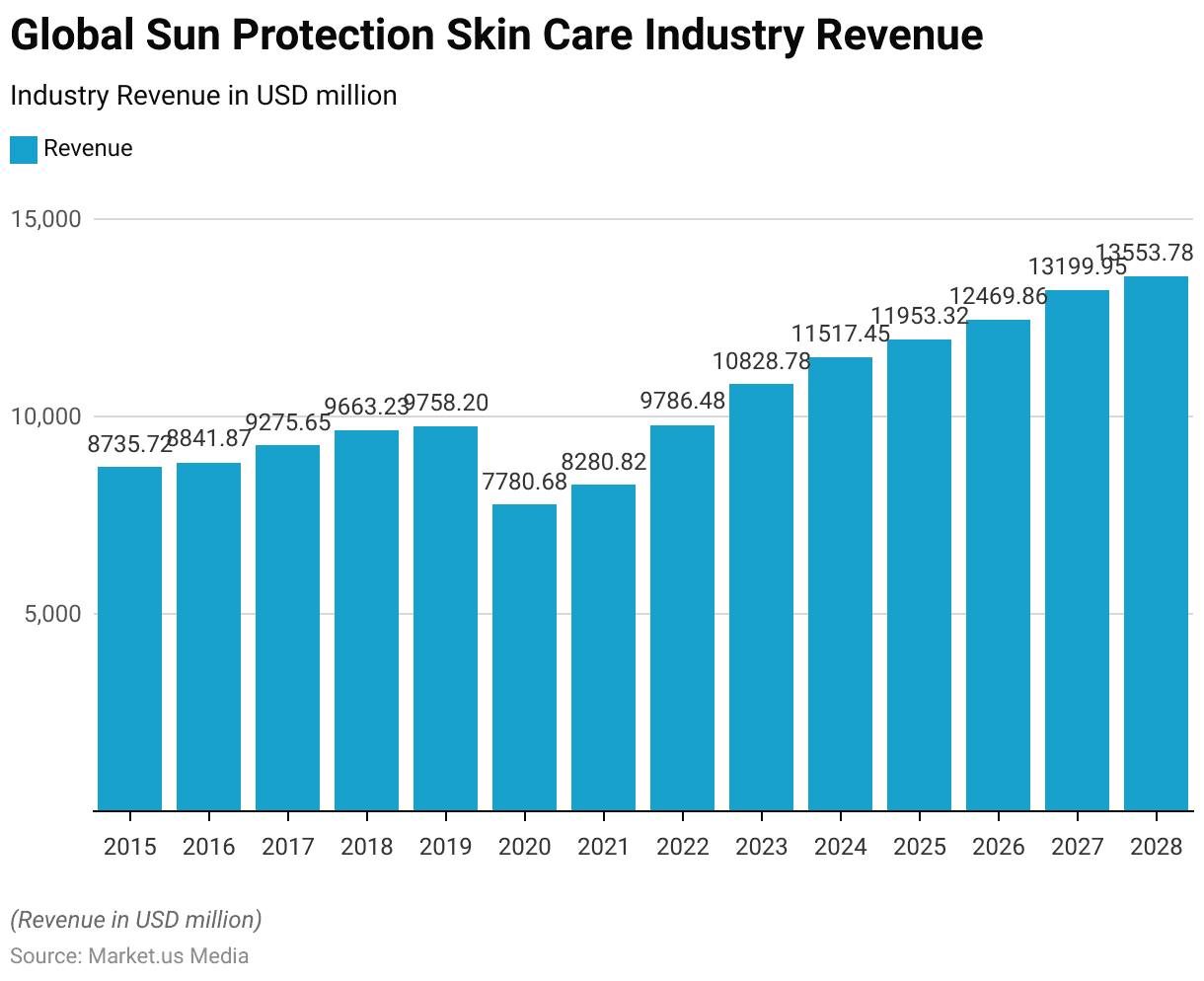
Revenue Growth of the Sun Protection Skin Care Market Worldwide
- The revenue growth of the sun protection skincare market worldwide has shown varied trends from 2019 to 2028.
- In 2019, the market saw a modest growth of 1%.
- However, in 2020, there was a significant downturn with a decrease of 20.30% in revenue growth, likely due to external economic impacts.
- The market began to recover in 2021 with a growth rate of 6.40%. Followed by a robust increase of 18.20% in 2022.
- The growth continued at a healthy rate of 10.70% in 2023.
- The following years showed a stabilization in growth rates. With 6.40% in 2024, 3.80% in 2025, 4.30% in 2026, and an increase to 5.90% in 2027.
- By 2028, the market growth rate is projected to moderate further to 2.70%.
- This data illustrates the fluctuations in the market’s performance over the decade, highlighting recovery and stabilization phases.
(Source: Statista)

Sun Protection Skin Care Market Revenue – By Country
- In 2023, the revenue generated from the sun protection skincare market varied significantly across different countries.
- The United States led with a substantial revenue of $1,983 million, followed by China with $1,075 million.
- South Korea also held a notable position, generating $790 million. India contributed $681 million, while Italy’s revenue stood at $498 million.
- France and Japan each generated $450 million.
- Russia and the United Kingdom closely followed with revenues of $423 million and $421 million, respectively.
- Spain generated $359 million, whereas Australia’s market contributed $259 million. Germany saw a revenue of $251 million.
- Less significant contributions came from Saudi Arabia with $187 million, Argentina with $182 million, and Brazil with $180 million.
- Indonesia, Switzerland, Canada, Portugal, and the Netherlands also had revenues in the market. Contributing $158 million, $130 million, $121 million, $102 million, and $102 million, respectively.
- This overview highlights the global distribution and economic impact of the sun protection skincare market across these nations in 2023.
(Source: Statista)
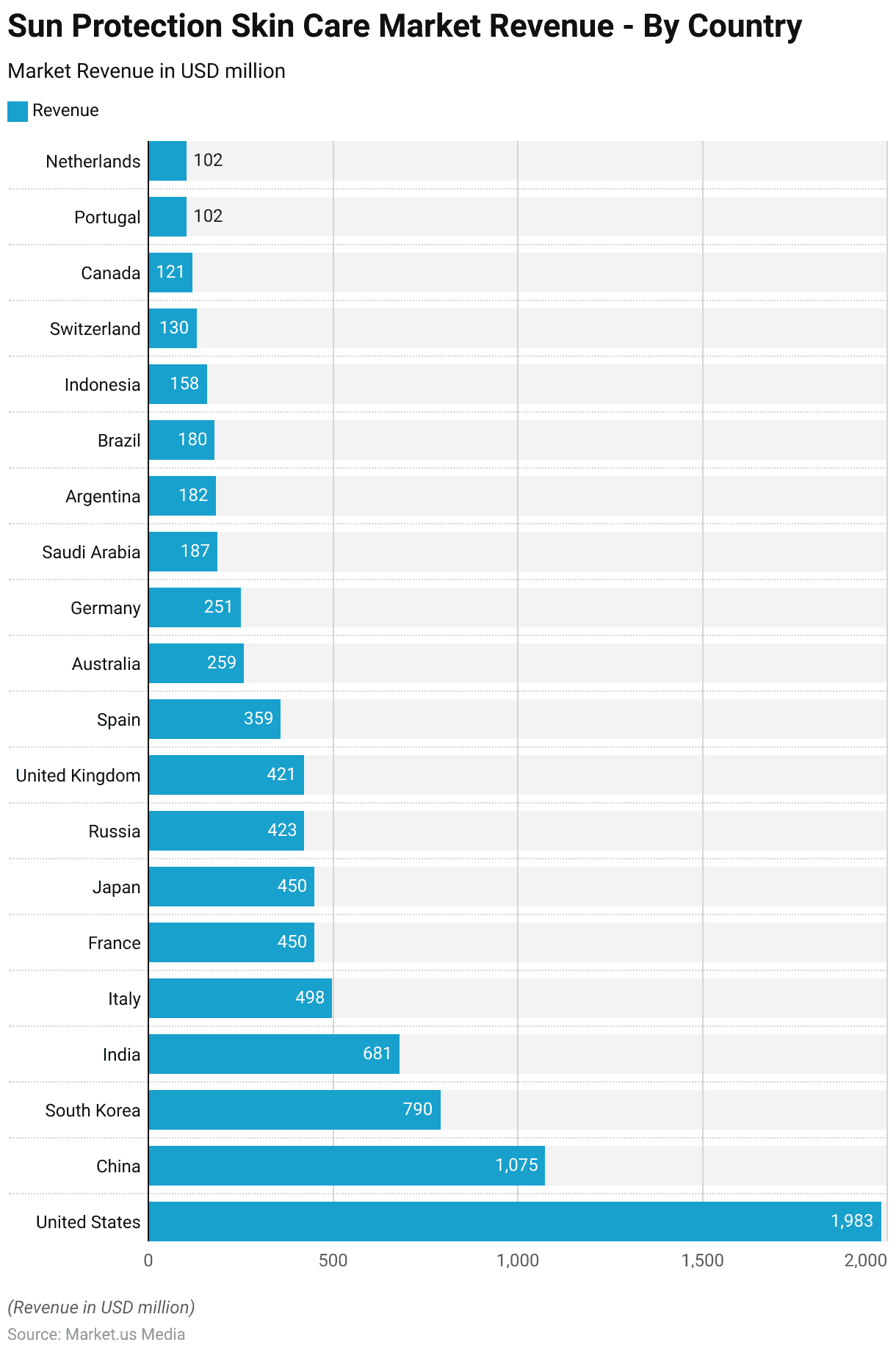
Sunscreen Cream Industry Statistics
Global Market Size of Sunscreen Cream
- The forecasted market value of sunscreen cream worldwide has shown positive growth between 2019 and 2024.
- In 2019, the market was valued at approximately $8,488.8 million.
- By 2024, this value is projected to increase significantly to $10,790 million.
- This represents substantial growth, underscoring an increasing demand and possibly greater consumer awareness of the importance of sun protection.
- The figures highlight the market’s potential for expansion over these five years.
(Source: Statista)

Sun Protection Users and Penetration Statistics
Users and Penetration Rate
- From 2017 to 2029, the number of sun protection users and the penetration rate in the market have both seen consistent growth.
- In 2017, there were 113.5 million sun protection users with a penetration rate of 3.2%.
- This figure increased to 133.2 million users in 2018, with a slight rise in the penetration rate to 3.5%.
- By 2019, the number of users grew to 156.0 million, with a penetration rate of 3.7%.
- The upward trend continued in 2020, reaching 180.4 million users and a penetration rate of 3.9%.
- In 2021, the number of users rose to 204.5 million with a penetration rate of 4.1%, and by 2022, there were 229.5 million users with a penetration rate of 4.3%.
- The rate stabilized at 4.3% in 2023, even as the number of users increased to 252.0 million.
- By 2024, the user base grew to 271.4 million, maintaining the same penetration rate of 4.3%.
- In 2025, the number of users rose further to 294.7 million, with a slightly higher penetration rate of 4.5%.
- The following years saw continued growth, reaching 316.3 million users in 2026 with a penetration rate of 4.7% and 336.3 million users in 2027 with a rate of 4.8%.
- By 2028, the user base expanded to 354.4 million with a penetration rate of 4.9%, and by 2029, it is projected to reach 370.6 million users with a penetration rate of 5.1%.
- This data underscores a growing awareness and adoption of sun protection products over the last twelve years.
(Source: Statista)
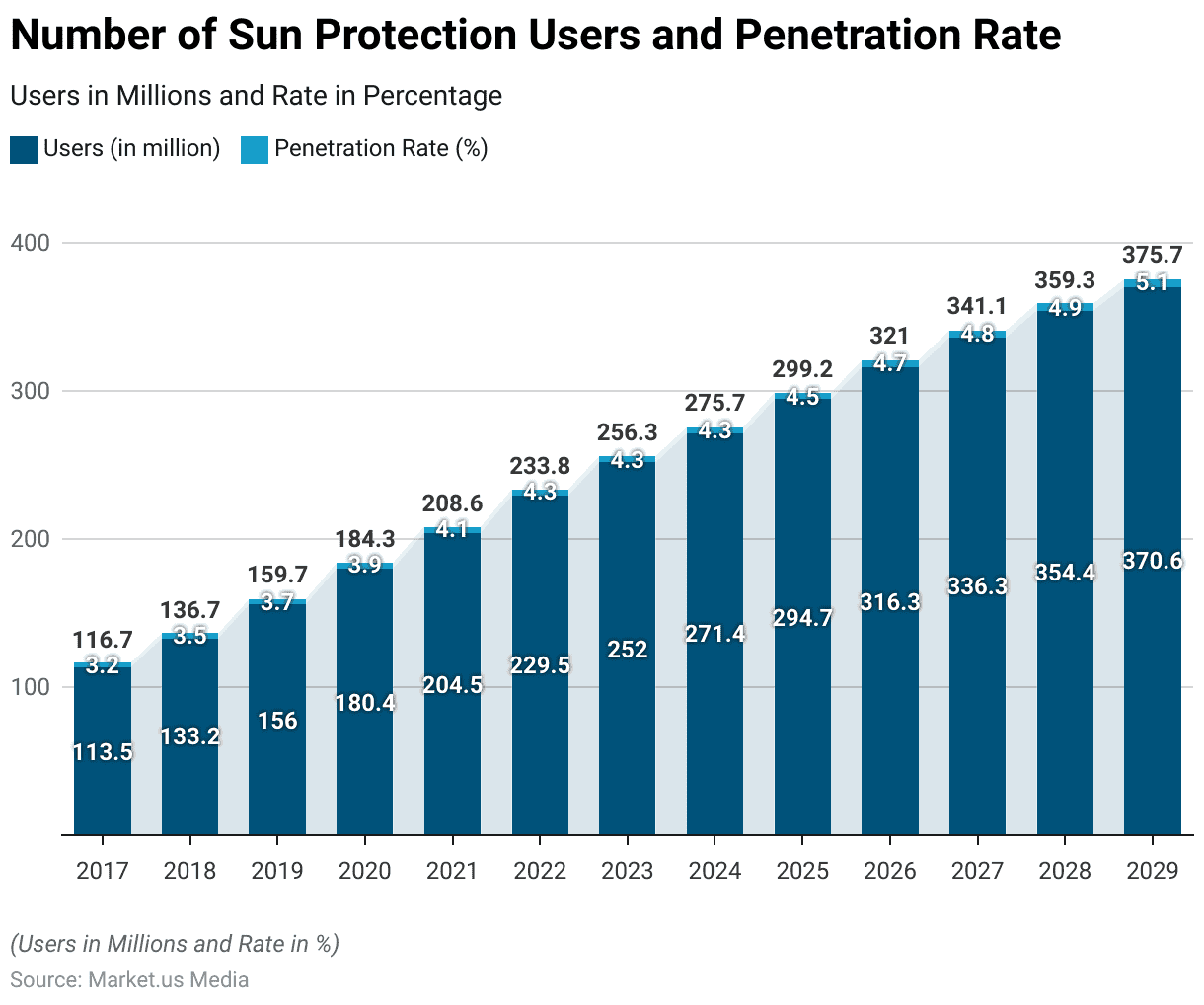
Average Revenue Per User
- The average revenue per user (ARPU) in the sun protection market exhibited fluctuations from 2017 to 2029.
- In 2017, the ARPU was $13.66, slightly decreasing to $13.46 in 2018 and further to $13.11 in 2019.
- A recovery was noted in 2020, with the ARPU rising to $14.03.
- A significant increase occurred in 2021, reaching $15.96, marking the highest point within the observed period.
- However, there was a decline to $13.68 in 2022, followed by a further drop to $12.84 in 2023.
- The ARPU then slightly recovered to $13.14 in 2024, followed by incremental rises each year: $13.56 in 2025, $14.02 in 2026, $14.32 in 2027, reaching $14.44 in 2028 and slightly decreasing to $14.42 by 2029.
- This data indicates variability in revenue generation per user over the years. Reflecting changes in market dynamics, consumer spending habits, and possibly the introduction of new products or pricing strategies.
(Source: Statista)

Sunscreen Product Usage Frequency
Frequency of Sun Care Product Use
- In February 2019, a survey regarding the frequency of sun care product usage among Indians revealed diverse habits.
- Approximately 32.77% of respondents reported using sun care products daily, highlighting significant routine incorporation.
- However, 25.62% of the surveyed individuals stated they never use sun care products.
- Those using products more than twice a week accounted for 14.61%, while 11.38% used them a few times a month.
- A smaller percentage, 9.75%, applied sun care products once a week, and 5.88% did so once a month.
- This distribution indicates varied engagement levels with sun care products among the Indian population, with a substantial number incorporating these products into their daily routines, while a notable proportion remains disengaged.
(Source: Statista)
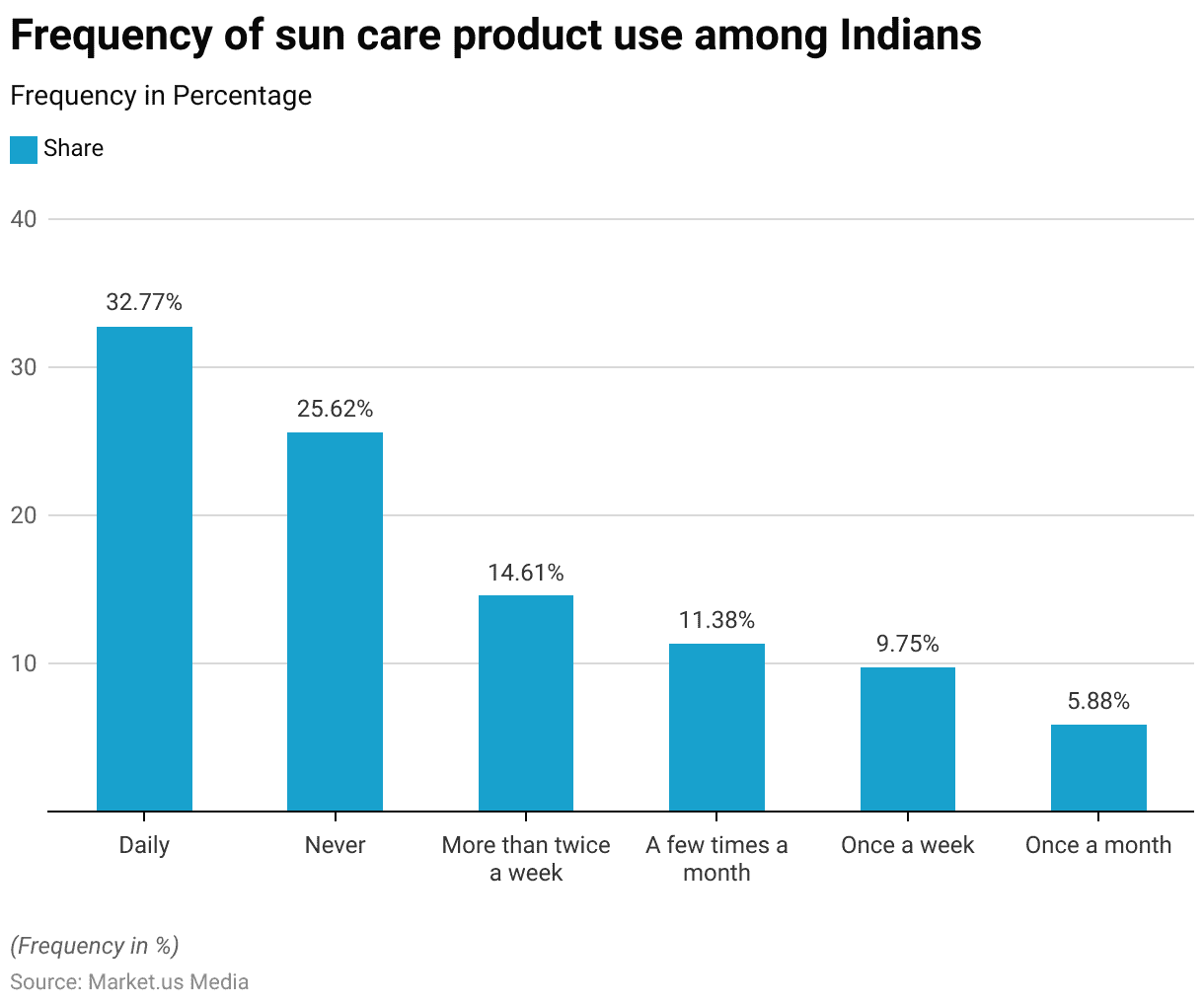
The Frequency With Which Sunscreen is Reapplied
- In a survey conducted in 2024 regarding sunscreen reapplication habits in the U.S., respondents displayed varied frequencies in their sunscreen reapplication practices when outdoors, swimming, or sweating.
- Only 10% of respondents reported that they always reapply sunscreen every two hours as recommended.
- A larger segment, 27%, stated they sometimes follow this practice.
- Meanwhile, 20% of respondents rarely adhere to the recommended reapplication frequency.
- A smaller percentage, 7%, admitted they never reapply sunscreen under these conditions.
- About 4% of the respondents were not sure of their reapplication habits.
- Notably, a significant portion, 33%, either were not asked this question or never used sunscreen at all.
- This data suggests a substantial variation in sunscreen usage habits among the U.S. population, highlighting a potential area for increased public health education on the benefits of regular sunscreen use.
(Source: Statista)
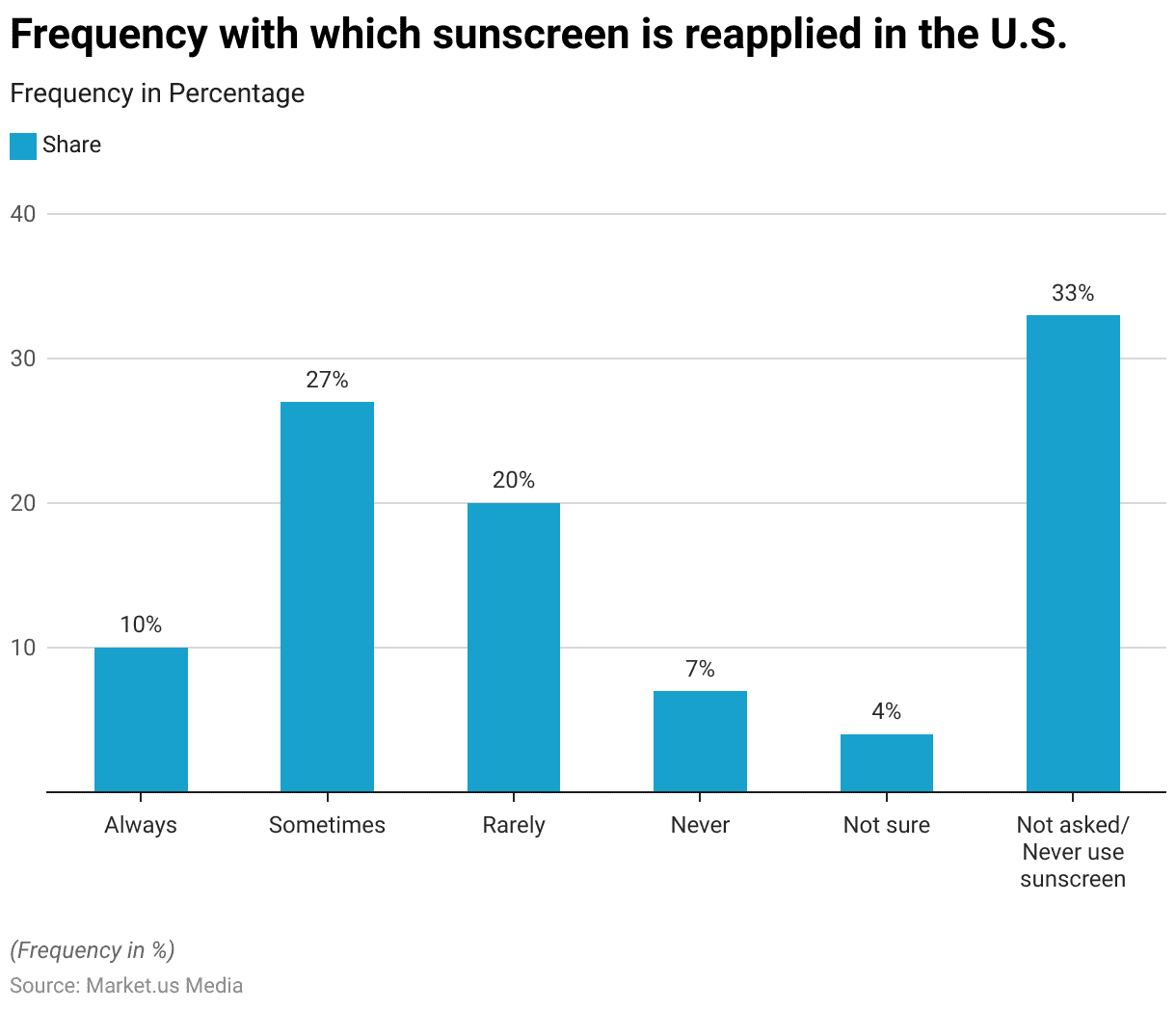
Usage Frequency of Face Tanning Products
- From 2011 to 2020, there were notable changes in the number of face suntan, sunscreen, after-sun, and sunless tanning products used by the U.S. population, measured in millions of consumers.
- In 2011, 10.68 million consumers used four or more bottles/tubes annually, while 36.41 million used just one bottle/tube, and 31.91 million used less than one.
- Those not using any amounted to 4.15 million.
- By 2012, usage of four or more bottles/tubes rose slightly to 11.84 million.
- This trend of gradual increases continued, with 2017 recording a peak usage of 12.46 million consumers for four or more bottles/tubes.
- However, the single largest category consistently remained those using one bottle/tube, reaching 41.76 million in 2020.
- Those using less than one bottle/tube also increased over the decade, culminating at 37.89 million in 2020.
- The number of non-users grew modestly, reaching 5.2 million in 2020.
- This data indicates a stable but slight growth in the usage of sun care products among the U.S. populace over the decade, alongside a small but steady rise in those opting not to use such products at all.
(Source: Statista)
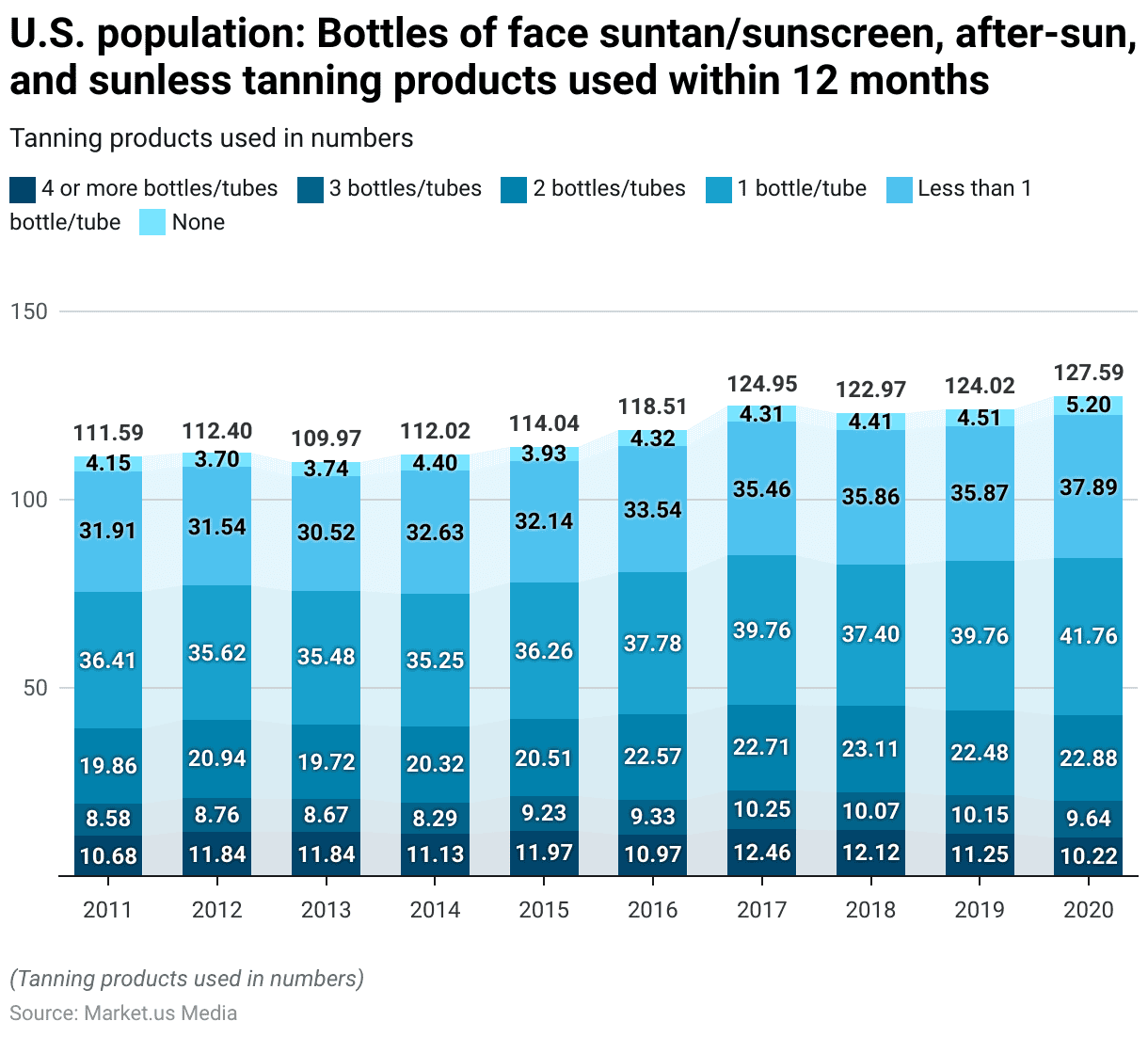
Most Used SPF Types
- In 2024, preferences for SPF types among consumers in the United States varied, with SPF 50 being the most commonly used, favored by 25% of respondents.
- This was closely followed by SPF 30, chosen by 23% of the participants, suggesting a strong preference for high but not the highest level of sun protection.
- SPF 15, offering lower protection, was used by only 6% of the respondents, indicating lesser popularity for minimal protection levels.
- Interestingly, SPF 100, which offers the highest level of protection, was used by a smaller segment of the population, at only 3%.
- This data illustrates a tendency among U.S. consumers to opt for mid to high-range SPF levels, balancing effective sun protection with usability and comfort.
(Source: Statista)

Age Dynamics
Global Sun Protection Products Usage Among Developed Markets – By Age
- In 2015 and 2016, the share of consumers in developed markets purchasing sunscreen or dedicated sun protection products exhibited a noticeable decline across various age groups.
- In 2015, Generation Z consumers represented 15% of this market, which slightly decreased to 13.50% by 2016.
- Millennials had a similar pattern, with a share of 14% in 2015, also reducing to 13.50% in 2016.
- Generation X showed the most significant drop, starting from 20% in 2015 to just 9% in 2016, halving their participation.
- Baby Boomers also saw a decrease in their share from 18% in 2015 to 12% in 2016.
- These figures suggest a trend of declining engagement with sun protection products among these demographic cohorts over the observed period.
(Source: Statista)
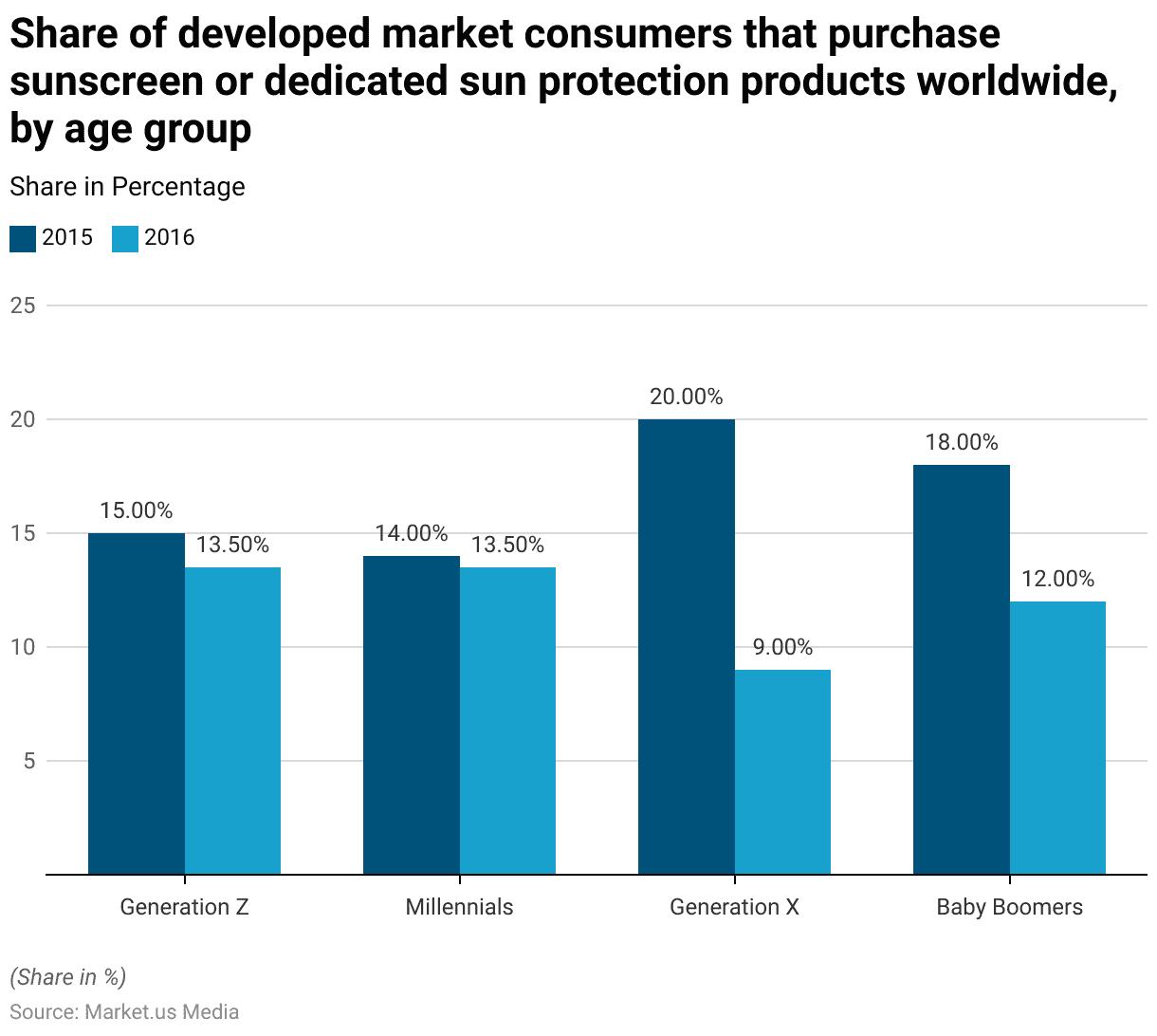
Age-wise Distribution of Sunscreen Users
- In 2018, the distribution of sunscreen users in Peru varied notably across different age groups.
- The highest percentage of users was found in the 35-44 years age group, which accounted for 23.10% of the respondents.
- This was closely followed by the 25-34 years age group, comprising 21.80% of the users.
- The 20-24 years age group had a smaller share, with 11.50% of users.
- Notably, the use of sunscreen decreased significantly with older age groups; those aged 55-64 years made up only 8% of the users, and the 65-75 years age group had the lowest usage at 3.70%.
- This data indicates that sunscreen use in Peru tends to decline with age, with the most significant usage concentrated among individuals in their mid-twenties to early forties.
(Source: Statista)

Usage of Makeup Products Containing SPF/Sunscreen – By Age
- In 2023, the usage of makeup products containing SPF/sunscreen in the United States varied significantly across different age groups.
- Among the general population, 65% were users of such products, 9% were intenders (those planning to use), and 26% were non-users.
- Notably, the 18-24 age group showed the highest usage at 72%, with 15% intenders and only 13% non-users, suggesting strong adoption among younger consumers.
- In contrast, the 25-34 years group had 62% users, 14% intenders, and 23% non-users.
- The 35-54 years age group reported the highest usage at 73%, with a lower intent rate of 6% and 21% non-users.
- The 55 years and older group displayed the lowest usage at 55%, with 5% intenders and the highest non-user rate at 40%.
- These statistics indicate a clear trend: younger individuals tend to use makeup products with sunscreen more frequently than older individuals, who show a substantial rate of non-use.
(Source: Statista)
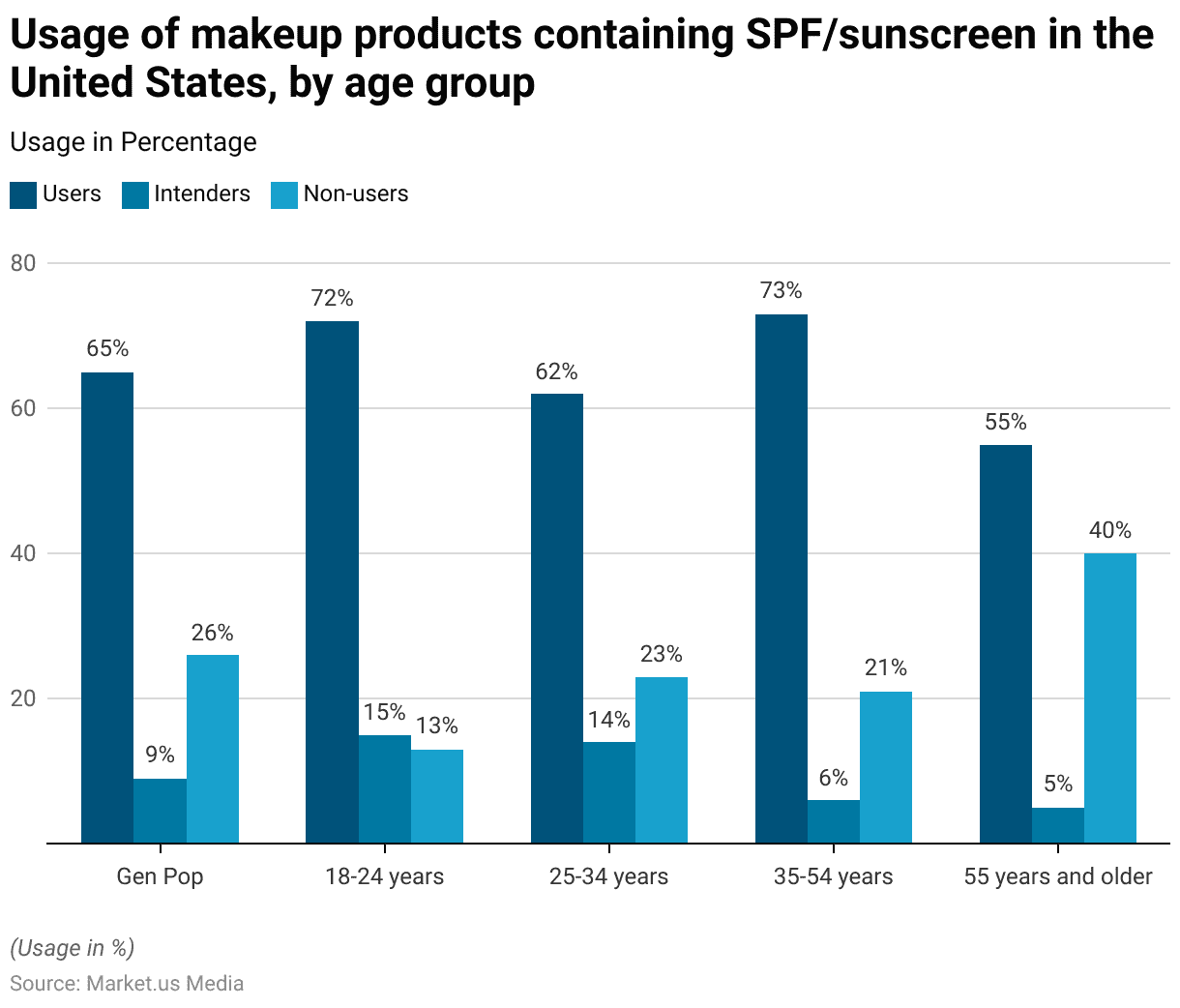
Use of Sunscreen On the Face When Outside of Home – By Age
- In the United States in 2023, sunscreen usage on the face when outside varied significantly across different age groups.
- Among those aged 18-29 years, 21% always used sunscreen, 32% used it most of the time, 29% some of the time, 13% never used it, and 5% were unsure.
- The 30-44 years age group showed similar patterns, with 20% always using sunscreen, 30% most of the time, 29% some of the time, 16% never, and 5% unsure.
- For the 45-64 years group, the consistent usage dropped, with only 12% always applying sunscreen, 18% most of the time, and a higher proportion, 35%, using it some of the time; 33% never used sunscreen, and 2% were unsure.
- The oldest group, those 65 and older, displayed the least frequent usage: only 10% always used sunscreen, 15% most of the time, and 36% some of the time, while the highest non-usage rate was at 37%, and 1% were unsure.
- This data illustrates a decline in regular sunscreen usage with increasing age, highlighting a potential area for targeted health promotions about the benefits of consistent sunscreen application.
(Source: Statista)
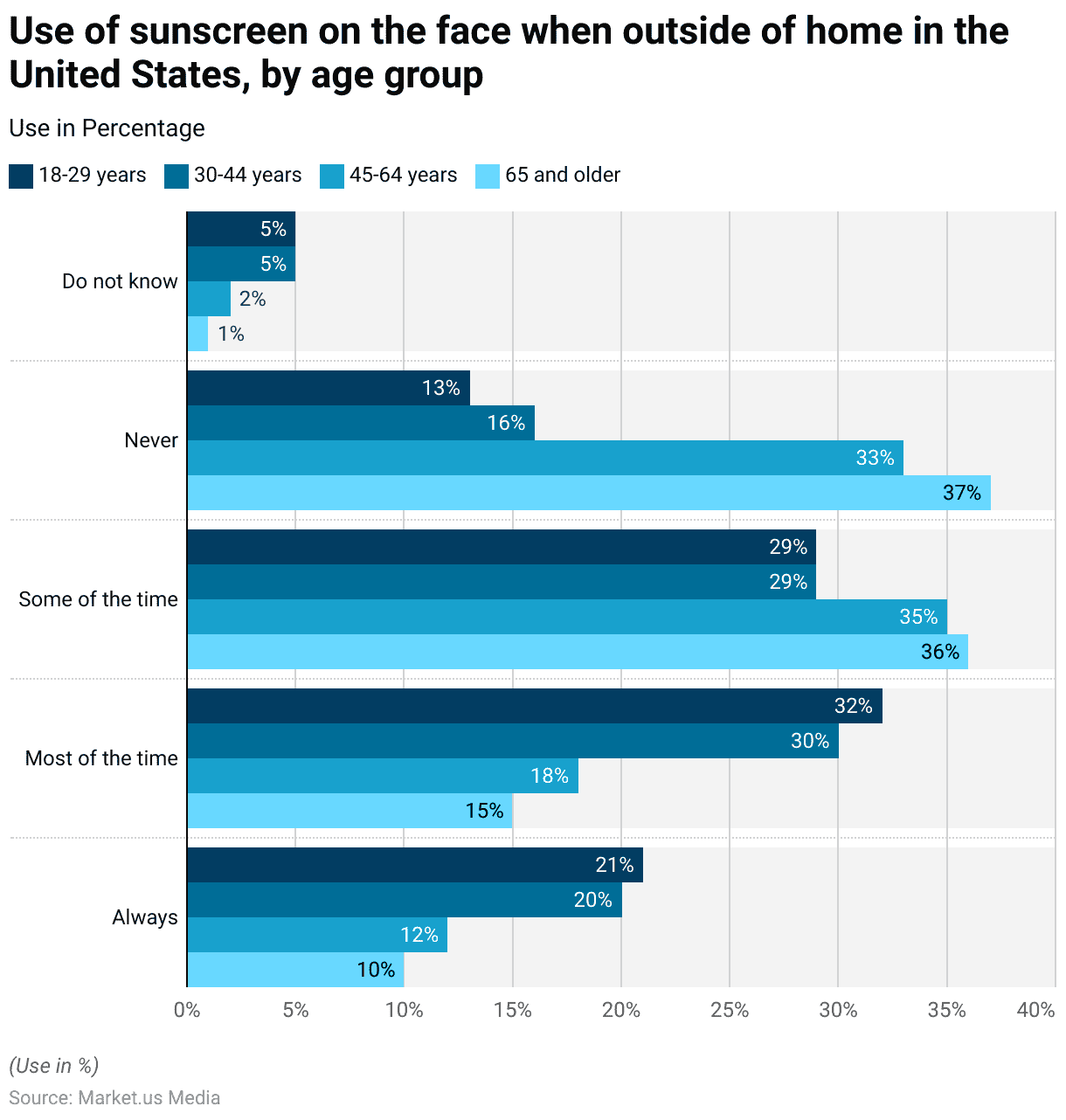
Consumers Interested in Sun Protection-related Content – By Age
- In April 2023, the interest in sun protection-related content among Chinese consumers showed a clear distribution across different age groups.
- The highest interest was observed in the youngest demographic, with 33.90% of respondents aged 24 years and younger engaging with sun protection content.
- This was followed by the 25-30 years age group, which accounted for 19.50% of the interested respondents.
- Interest appeared to decline with age, as seen with 10.70% of those aged 31-35 years and 10.40% of those in the 36-40 years age bracket.
- The 41-45 years and 46-50 years groups showed even less interest, contributing 6.20% and 6.90%, respectively.
- However, there was a noticeable increase among those aged 50 years and older, with 12.50% showing interest in sun protection content.
- This data highlights a significant variation in the engagement with sun protection topics across different age groups in China, with younger individuals showing the most interest.
(Source: Statista)

Gender Dynamics
The Frequency of Use of Body Sunscreen – By Gender
- In 2022, the frequency of body sunscreen use in the United States showed distinct patterns between genders.
- Among men, only 8% reported using sunscreen most or all of the time, compared to 17% of women who did so.
- A majority of both genders, 53% of men and 55% of women stated that they use sunscreen sometimes.
- However, a significant proportion of men, 39%, reported that they rarely or never use body sunscreen, which is higher than the 28% of women who reported the same.
- This data highlights a gender disparity in sunscreen usage, with women generally using sunscreen more frequently than men.
(Source: Statista)
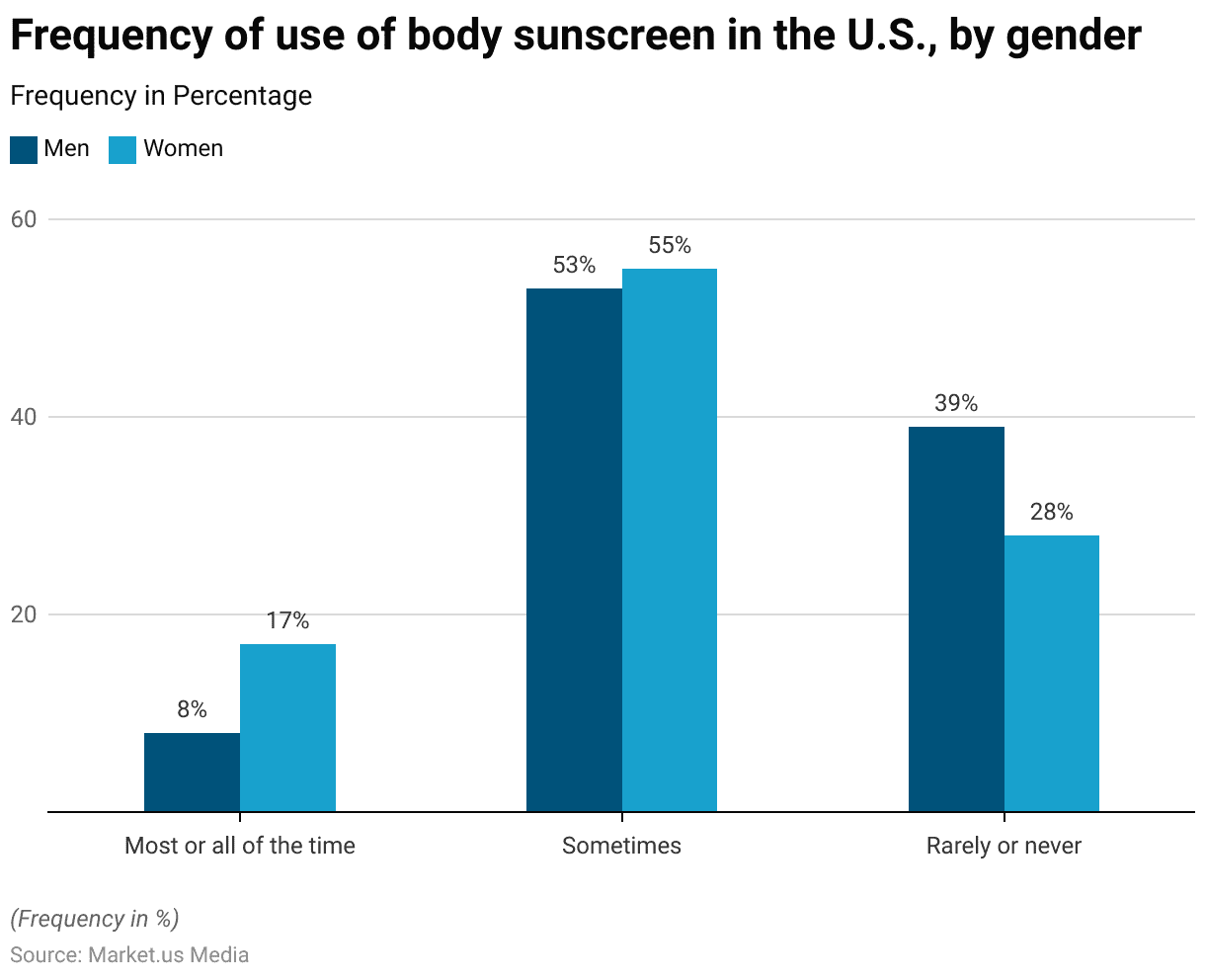
Frequency of Use of Face Sunscreen – By Gender
- In 2022, the usage patterns of face sunscreen in the United States displayed significant differences between men and women.
- Women showed a higher frequency of usage, with 44% reporting that they use face sunscreen most or all of the time, compared to only 15% of men.
- Additionally, 38% of women and 48% of men said they sometimes use face sunscreen.
- The disparity is more pronounced in the rarely or never category, where 37% of men reported minimal or no use of face sunscreen, almost double the rate of women at 18%.
- This data underscores a substantial gender gap in face sunscreen usage, with women being considerably more diligent in their use compared to men.
(Source: Statista)
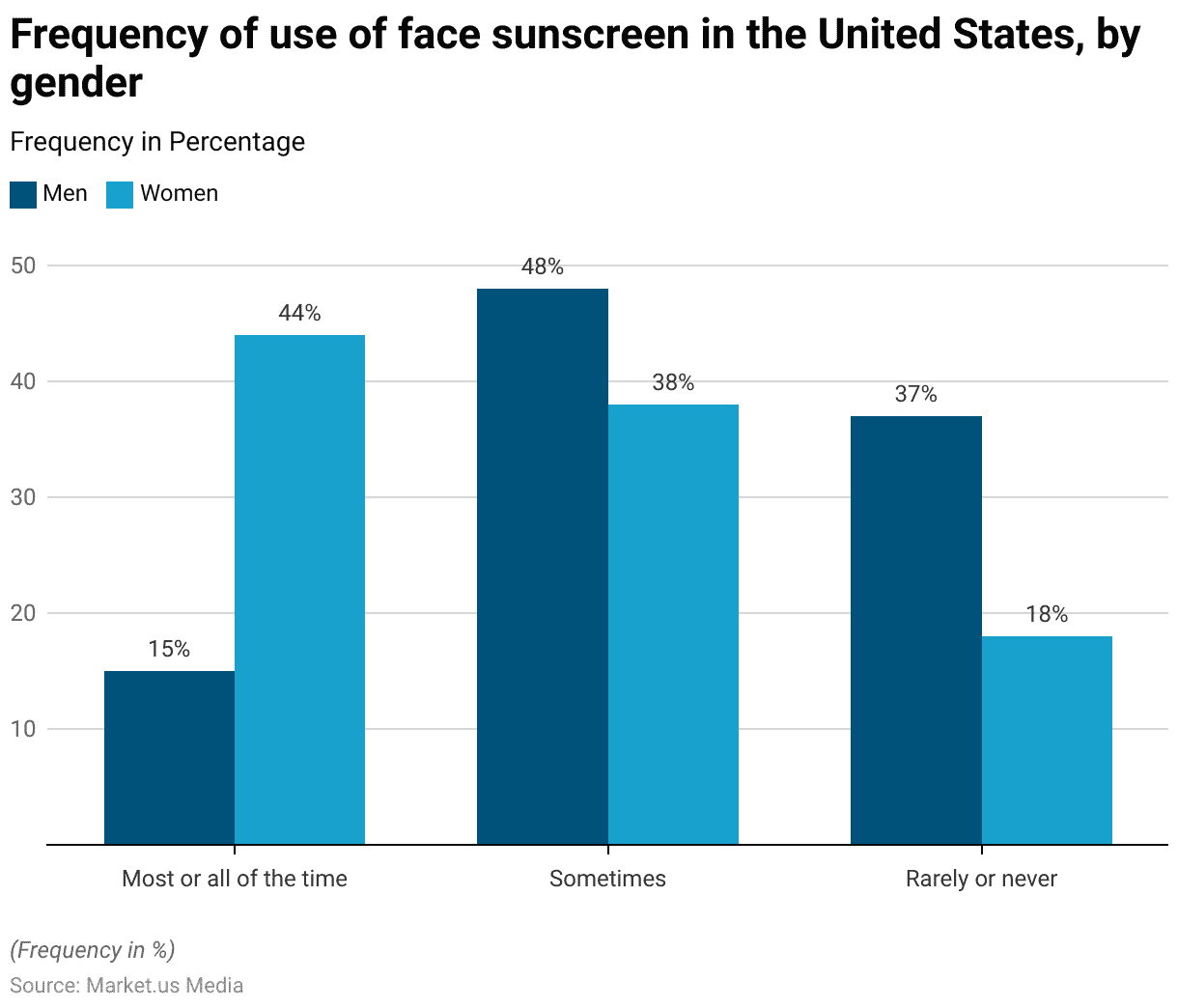
The Frequency of Use of Products Containing SPF – By Gender
- In 2023, the frequency of usage of products containing SPF in the United States varied significantly between men and women.
- Women reported higher daily use of SPF products at 32%, compared to only 8% of men.
- Men were slightly more likely than women to use SPF products at least once a week, at 11% versus 9%.
- Usage several times a month was relatively similar between genders, with men at 15% and women at 13%.
- However, a large percentage of both men (37%) and women (32%) said they rarely use SPF products.
- Notably, the proportion of men who never wear sunscreen was significantly higher at 29%, compared to 13% of women.
- This data highlights a considerable gender disparity in SPF product usage, with women generally engaging more in sunscreen application compared to men.
(Source: Statista)
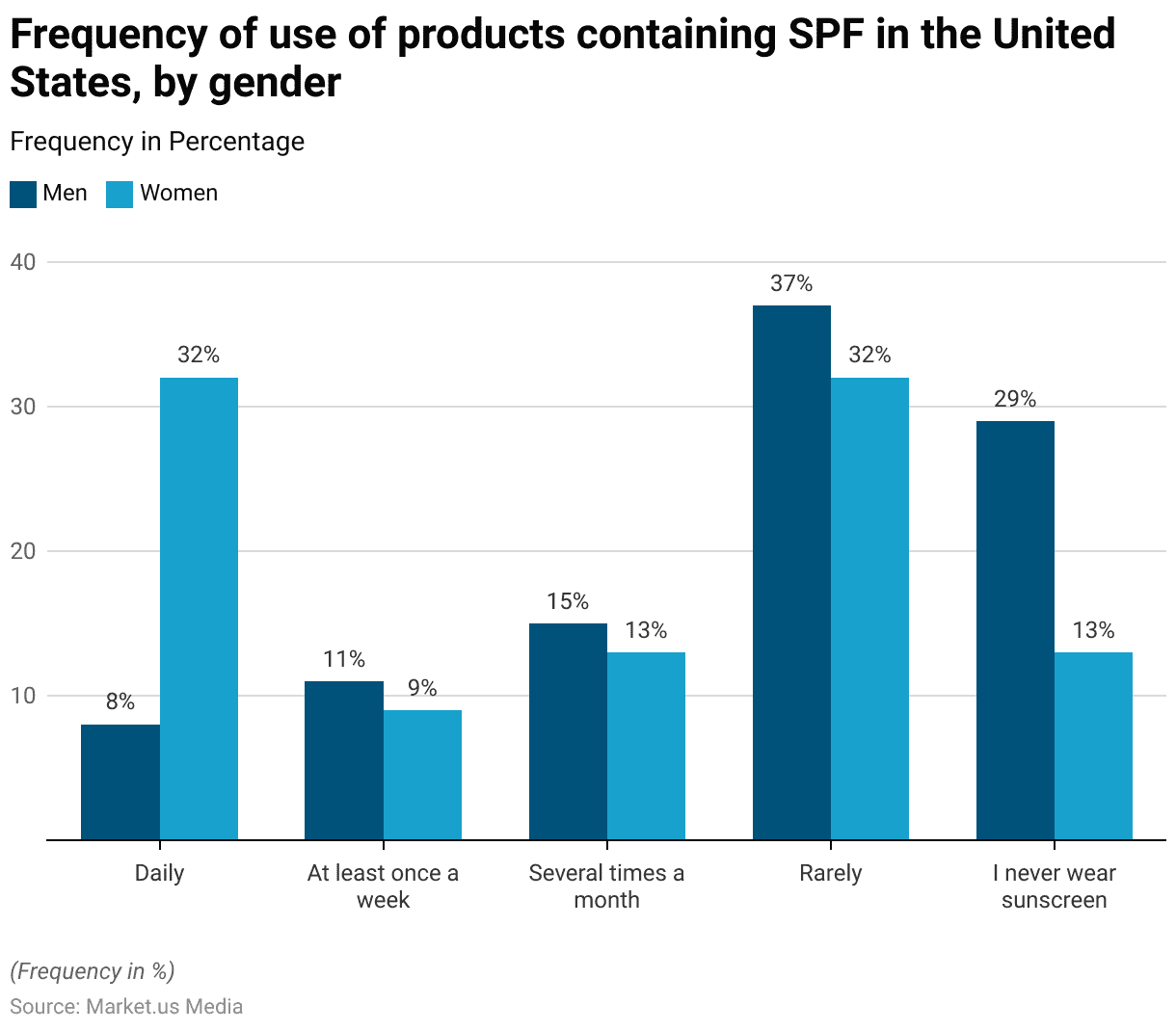
Frequency of Face Sunscreen Use When Outside Among Men
- In 2023, the frequency of face sunscreen use among men in the U.S. when outside displayed a range of behaviors.
- About 14% of respondents reported that they always use sunscreen, while 24% said they use it most of the time.
- The largest group, constituting 35%, mentioned using sunscreen only some of the time.
- However, a significant portion, 27%, reported that they never use sunscreen when outside.
- Additionally, a small percentage (3%) were unsure about their sunscreen usage habits.
- This data indicates a varied commitment to face sunscreen use among men, with a notable segment entirely neglecting its use.
(Source: Statista)
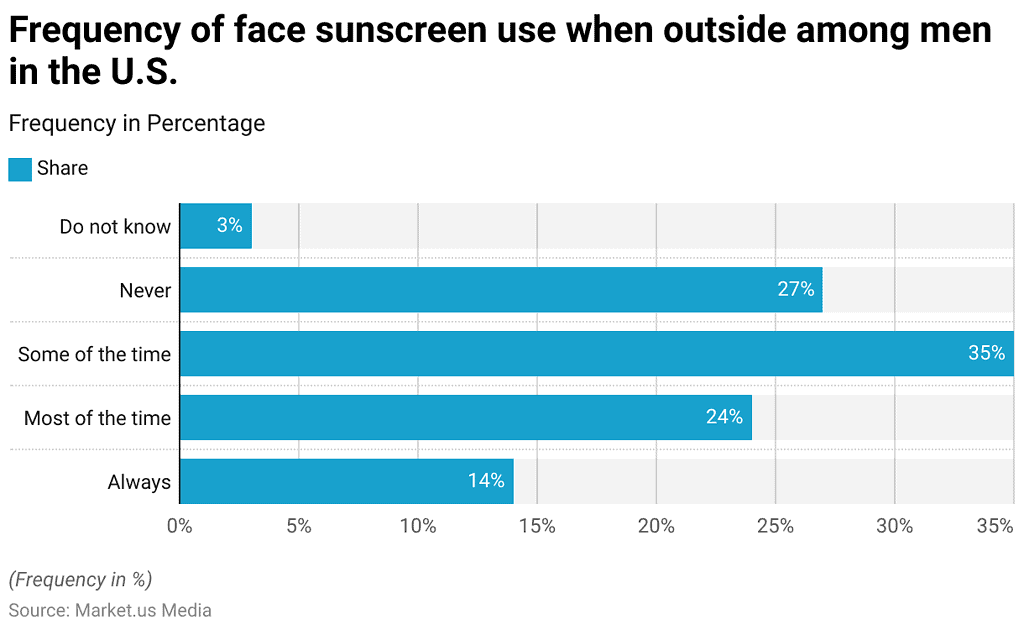
Frequency of Face Sunscreen Use When Outside Among Women
- In 2023, the usage patterns of face sunscreen among women in the U.S. when outdoors showed varied commitment levels.
- 18% of the respondents reported that they always use sunscreen, while 24% indicated they use it most of the time.
- The largest proportion, 32%, stated that they apply sunscreen some of the time.
- Conversely, a notable 23% of women reported that they never use sunscreen when outside.
- Additionally, 3% of respondents were unsure of their sunscreen usage frequency.
- These figures highlight a broad spectrum of sunscreen application habits among women, with a considerable portion either consistently using it or completely previous it when outdoors.
(Source: Statista)

Sunscreen Product Price Statistics
Price of the Leading Suntan Lotion and Oil Brands
- In 2023, the prices per unit for leading suntan lotion and oil brands in the United States varied significantly.
- Neutrogena products were priced at $11.23 each.
- Banana Boat offered a lower price point at $9.07, while Copperstone was slightly higher at $9.99.
- Private-label brands presented the most economical option at $6.43.
- Sun Bum was on the higher end of the spectrum at $15.40.
- Hawaiian Tropic was moderately priced at $10.95.
- Among the premium brands, La Roche-Posay stood out with a price of $31.38 per unit, the highest among the listed brands.
- Cerave and Jergens were also priced higher at $14.72 and $13.64, respectively. B Tan offered its products at $9.53 each.
- These prices reflect a wide range of options available to consumers, from budget-friendly choices to high-end products.
(Source: Statista)
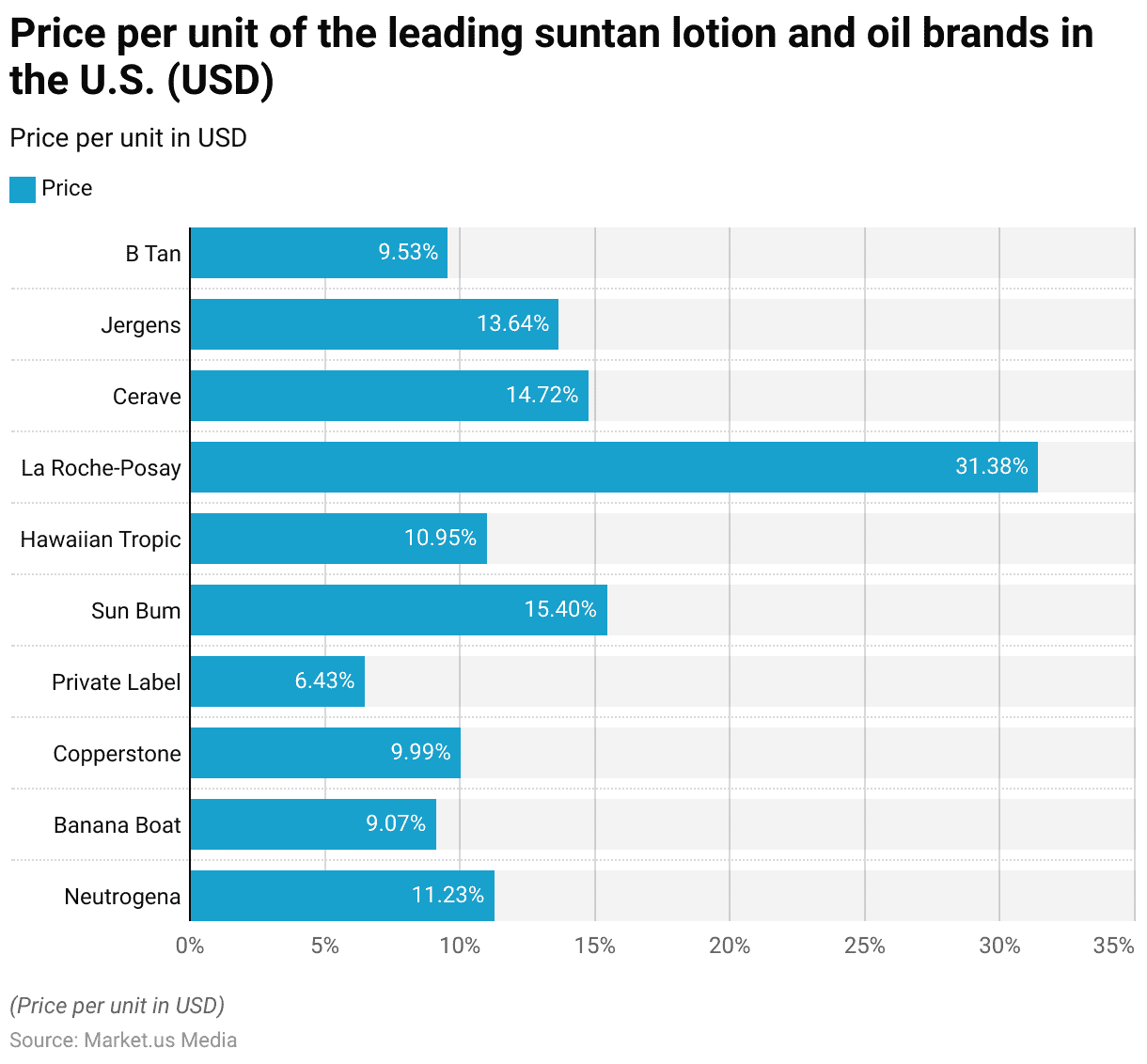
Suntan Products Price
- In 2019, the average price per unit for suntan products in the U.S. displayed minimal variation across different categories.
- The price for both suntan lotion and oil stood at $8.54 per unit.
- Similarly, the category of sunscreen combined with insect repellent was priced almost identically at $8.53 per unit.
- The overall average price for all categories combined, referred to as the category total, was also $8.54.
- This pricing indicates a uniform valuation across these closely related product categories, reflecting consistent market pricing strategies for suntan-related products during that year.
(Source: Statista)
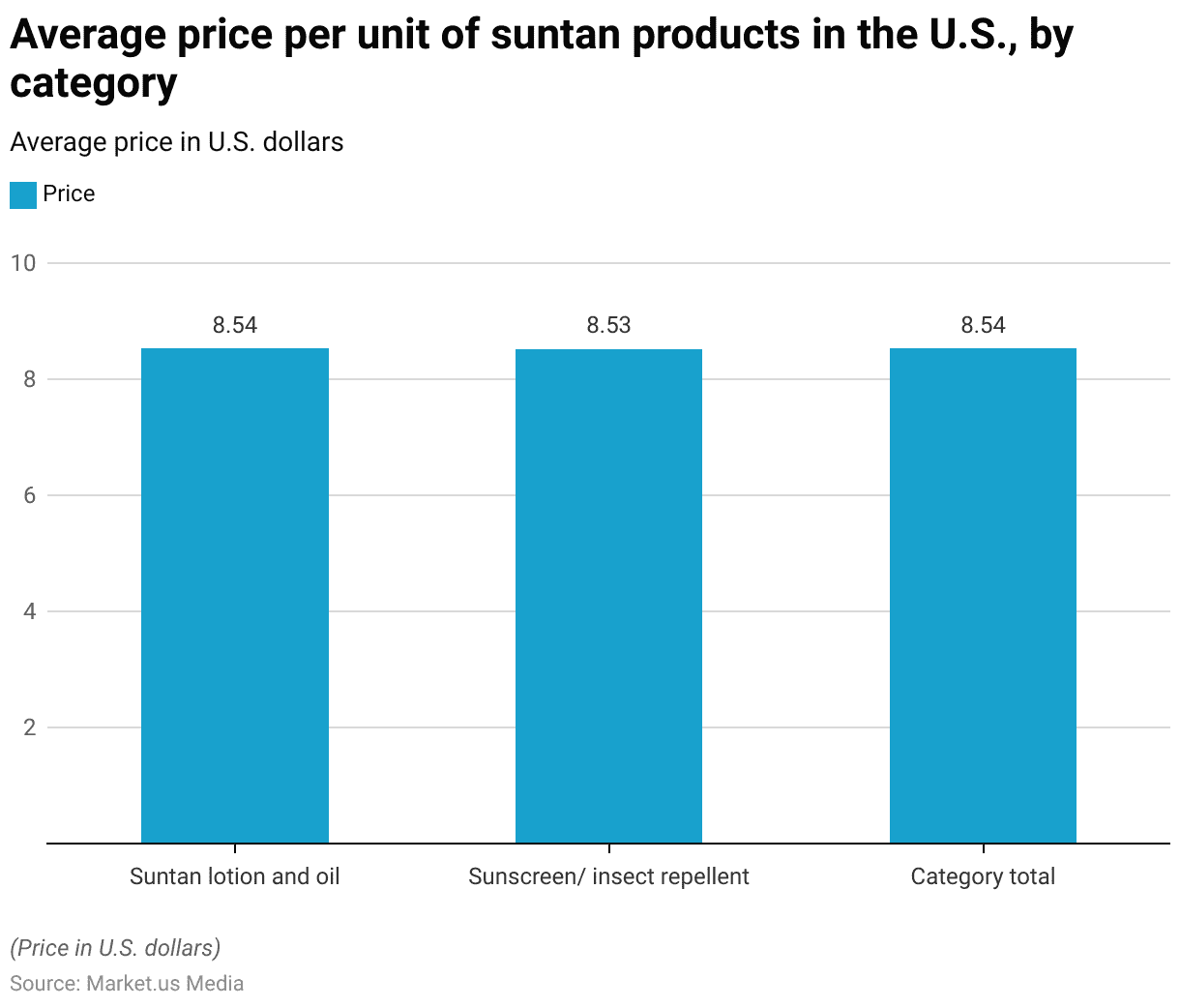
Price Acceptance for Sun Protection Cosmetics
- In March 2024, consumer preferences in China regarding the price range for a 60g sun protection cream or lotion were surveyed, revealing specific price tolerances.
- A small segment of consumers, 5.70%, were willing to pay less than 50 yuan.
- The majority of consumers preferred more moderate pricing, with 46.10% finding the price range of 50-99 yuan acceptable and another significant portion, 41.20%, comfortable with the range of 100-149 yuan.
- Only a minority of 7% were willing to pay 150 yuan and above for their sun protection products.
- This distribution indicates a concentration of consumer preference within the mid-range price brackets, suggesting that most consumers seek affordable but perhaps moderately priced sun protection options.
(Source: Statista)
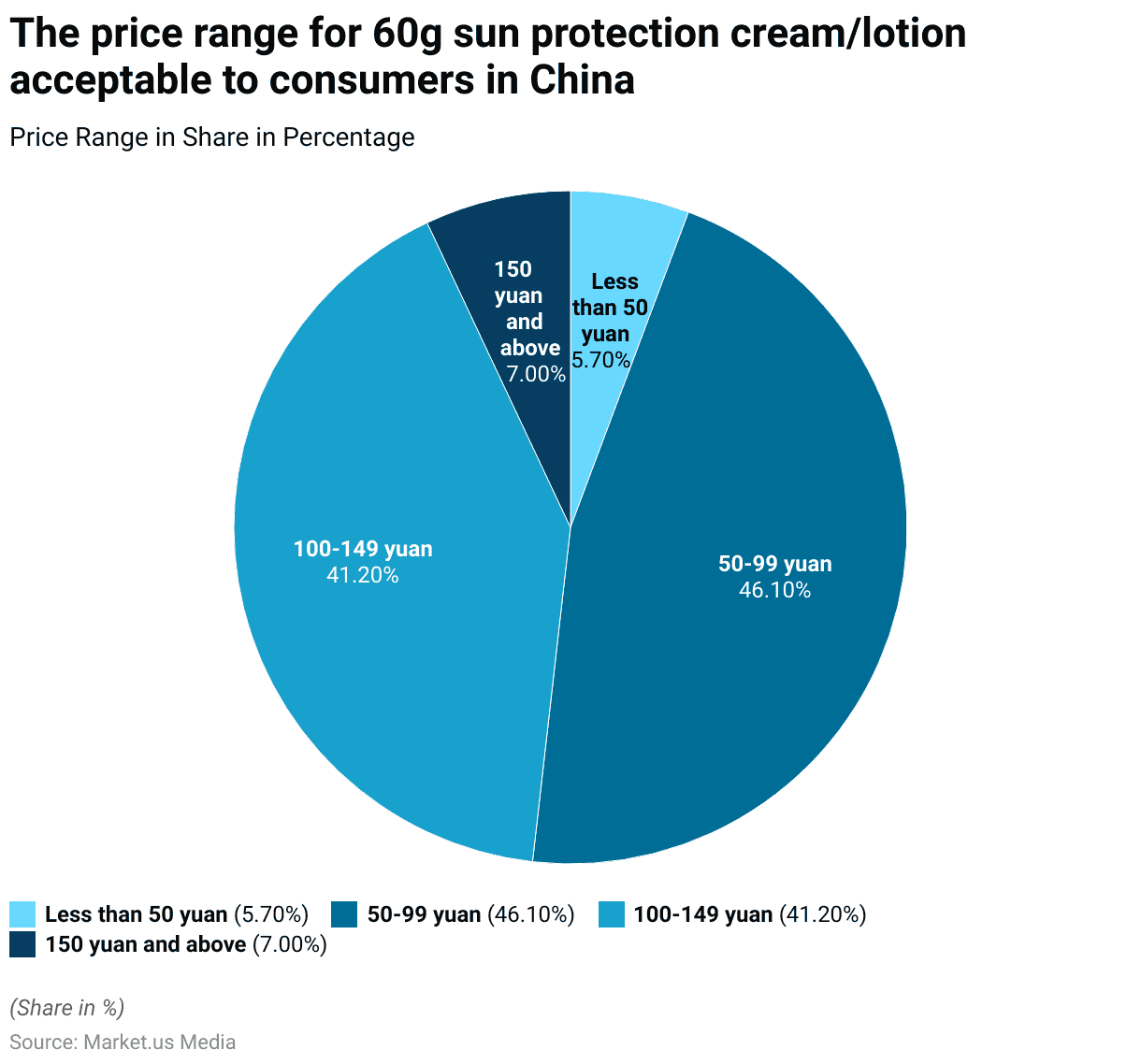
Price of Sun Care Products in Pharmacies
- From 2020 to 2024, the average price of sun care products in pharmacies in Italy showed a general upward trend.
- In 2020, the average price per unit was €16.72.
- This decreased slightly in 2021 to €16.52 but rebounded in 2022 to €17.07.
- The upward trajectory continued into 2023, where the average price rose to €18.20.
- By 2024, the average price further increased to €19.10 per unit.
- This progression reflects a steady rise in the cost of sun care products over these years, indicating potential inflationary pressures or increases in market value for these products within the Italian pharmaceutical retail sector.
(Source: Statista)
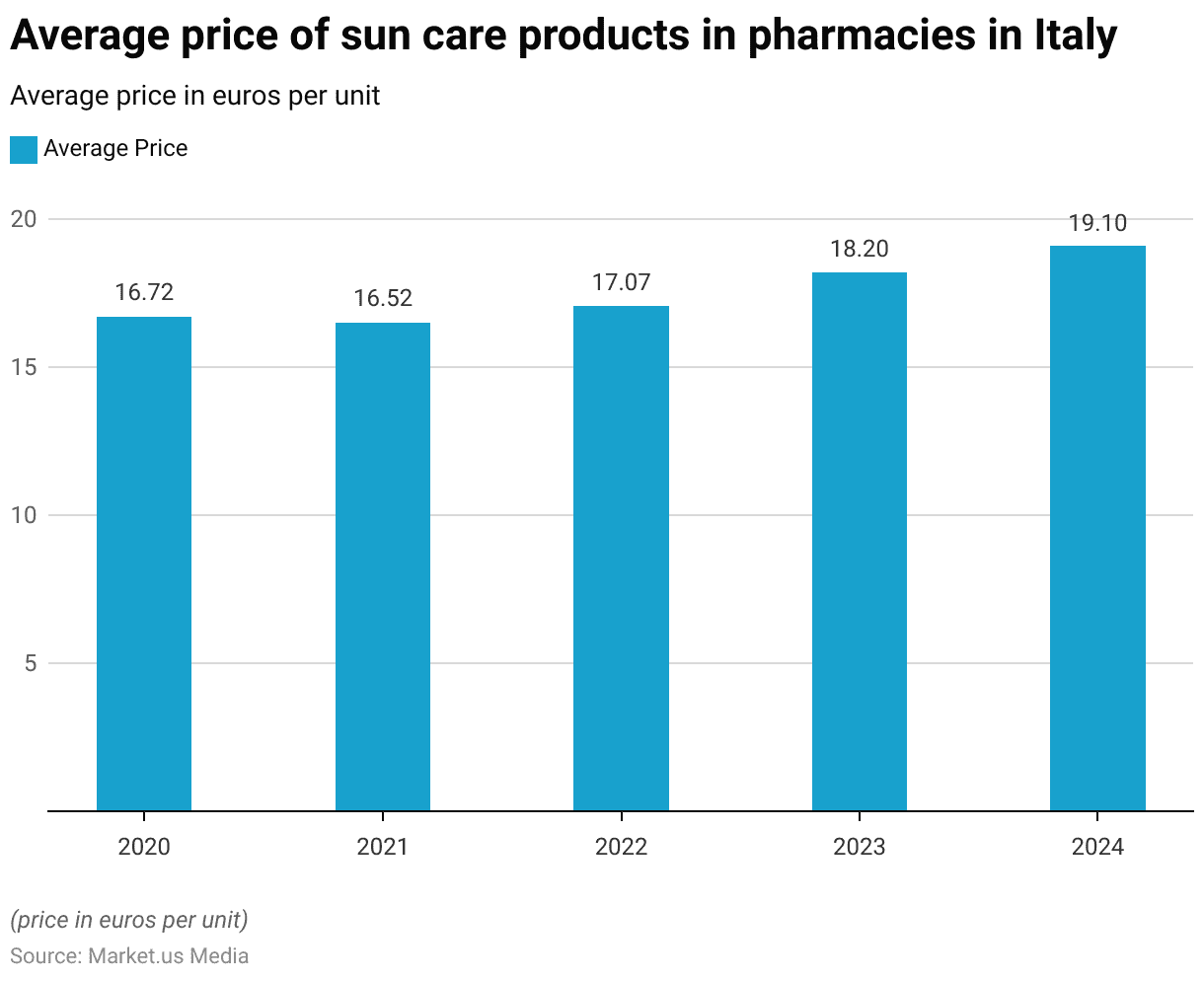
Consumer Preferences and Trends
Key Factors Evaluated When Buying Sunscreen
- In France, in 2022, consumers considered various factors when purchasing sunscreen, with the effectiveness of protection being the paramount concern for 45% of respondents, emphasizing the primary function of sunscreen in safeguarding against sun damage.
- Price was also a significant factor for 10% of the buyers, indicating cost sensitivity among some users.
- Brand loyalty influenced 7% of the choices, while 6% preferred sunscreens containing natural ingredients, reflecting a growing trend towards more organic product options.
- Water resistance was important for 5% of the consumers, which is crucial for maintaining protection while swimming or sweating.
- Other considerations included the lack of allergens and environmentally friendly compositions, each valued by 4% of respondents, showcasing a sensitivity to both personal and environmental health.
- Smaller proportions of the population prioritized aspects like the absence of chemical filters, quick absorption, pleasant scent, product longevity, and availability in stores, each scoring between 2% and 3%.
- Notably, 6% of respondents were unsure of what factors they consider important, indicating some level of uncertainty or indifference in their purchasing decisions for sunscreen.
(Source: Statista)

Outlets to Buy Sunscreen
- In 2019, the purchasing locations for sunscreen in France were predominantly large shopping areas, such as supermarkets and hypermarkets, where 69% of respondents indicated they buy their sunscreen, highlighting the convenience and accessibility of these venues.
- Pharmacies and drugstores were also a popular choice, with 53% of consumers purchasing their sunscreen there, possibly due to the trust in pharmaceutical advice or the availability of specialized sun care products.
- Far fewer consumers, 9%, opted to buy sunscreen in perfumeries, which might offer premium or niche brands.
- Online purchases were the least common, with only 6% of respondents buying sunscreen through online platforms, reflecting perhaps a preference for physical inspection and immediate availability offered by brick-and-mortar stores.
(Source: Statista)
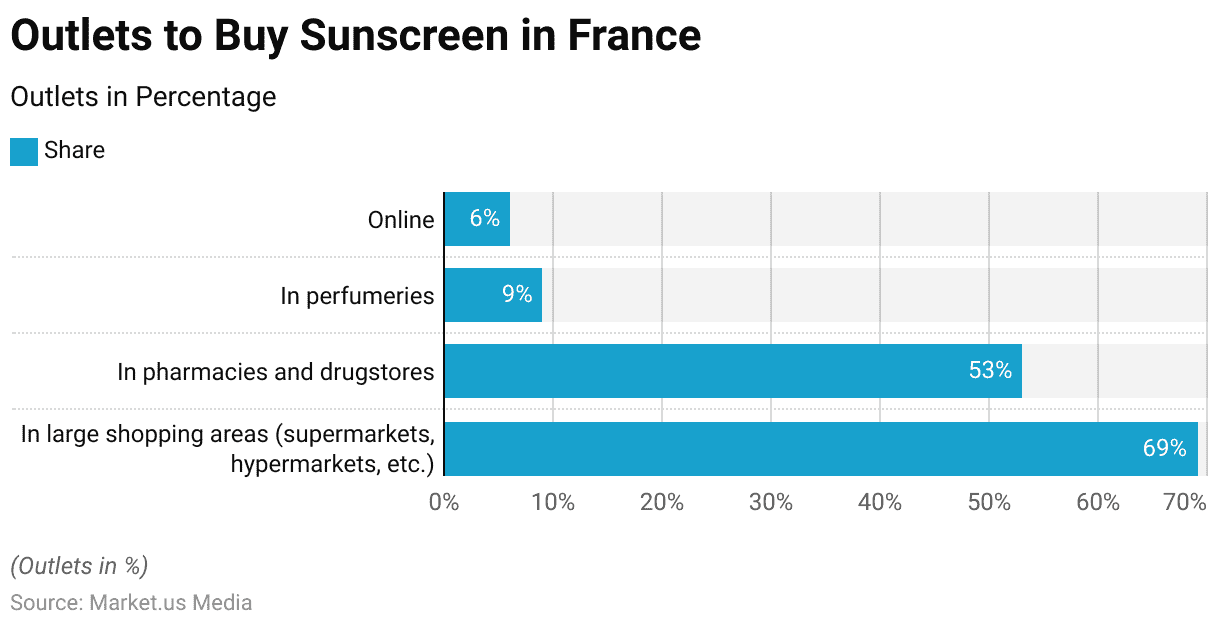
Leading Factors Considered When Buying Sunscreen
- In 2023, American consumers considered various factors when purchasing sunscreen, with protection against UVB/UVA rays being the most significant, influencing 53% of respondents.
- Water resistance was also highly valued, with 45% seeking waterproof or water-resistant formulas.
- The form of the product, such as gel, lotion, or spray, was important for 34% of the buyers, highlighting the preference for specific application types.
- 30% of consumers looked for products suitable for sensitive skin, emphasizing the need for gentler formulations.
- Natural ingredients were a priority for 28% of respondents, reflecting a trend towards more organic and eco-friendly products.
- Special offers attracted 23% of shoppers, indicating that pricing and promotions were influential.
- Brand recognition affected 22% of the decision-making process, suggesting a significant trust in established brands.
- 19% of buyers preferred non-chemical (mineral) formulas, which are often recommended for those seeking natural options.
- Another 19% favored packages that included both sun protection and after-sun care, offering added value.
- Products specifically suitable for babies or children were considered by 17% of respondents, showing the importance of specialized protection for younger skin. The same percentage sought products that require only once-a-day application for convenience.
- Family-size packaging appealed to 16%, catering to households looking for bulk purchases.
- Lastly, 4% cited other factors, reflecting diverse and individual preferences not captured by the main categories.
- This data demonstrates a wide range of priorities among U.S. consumers, underlining the diverse needs and preferences in sun care products.
(Source: Statista)

Popularity of Sunscreen Brands
- In 2023, a survey regarding the popularity of selected sunscreen brands in the United States revealed varied levels of consumer preference and brand familiarity.
- Coppertone was well-received, with 9% of respondents expressing strong affection (“I love it”) and 49% liking it, although 10% did not like it, and 31% had never used it.
- Banana Boat showed similar approval, with 10% loving it and 46% liking it, accompanied by a 9% disapproval rate and 35% unfamiliarity.
- Hawaiian Tropic had 9% of respondents indicating they love it, 39% liking it, but also a 10% disapproval and 42% had never used it.
- Neutrogena, another major brand, had the highest strong approval rating at 12%, with 34% liking it, but also showed a high unfamiliarity rate at 46% and 8% disliking it.
- Sun Bum and Blue Lizard were less familiar to the survey participants, with 72% and 80%, respectively, having never used them.
- Of those familiar, Sun Bum had 6% who loved it and 13% who liked it, while Blue Lizard had 4% strong approval and 8% approval. Disapproval rates for these brands were relatively low, suggesting limited negative experiences among those who had tried them.
- Overall, the survey data indicates that while some brands like Coppertone and Banana Boat enjoy widespread recognition and generally positive perceptions, others like Sun Bum and Blue Lizard are less known, which could influence consumer choices and market dynamics.
(Source: Statista)
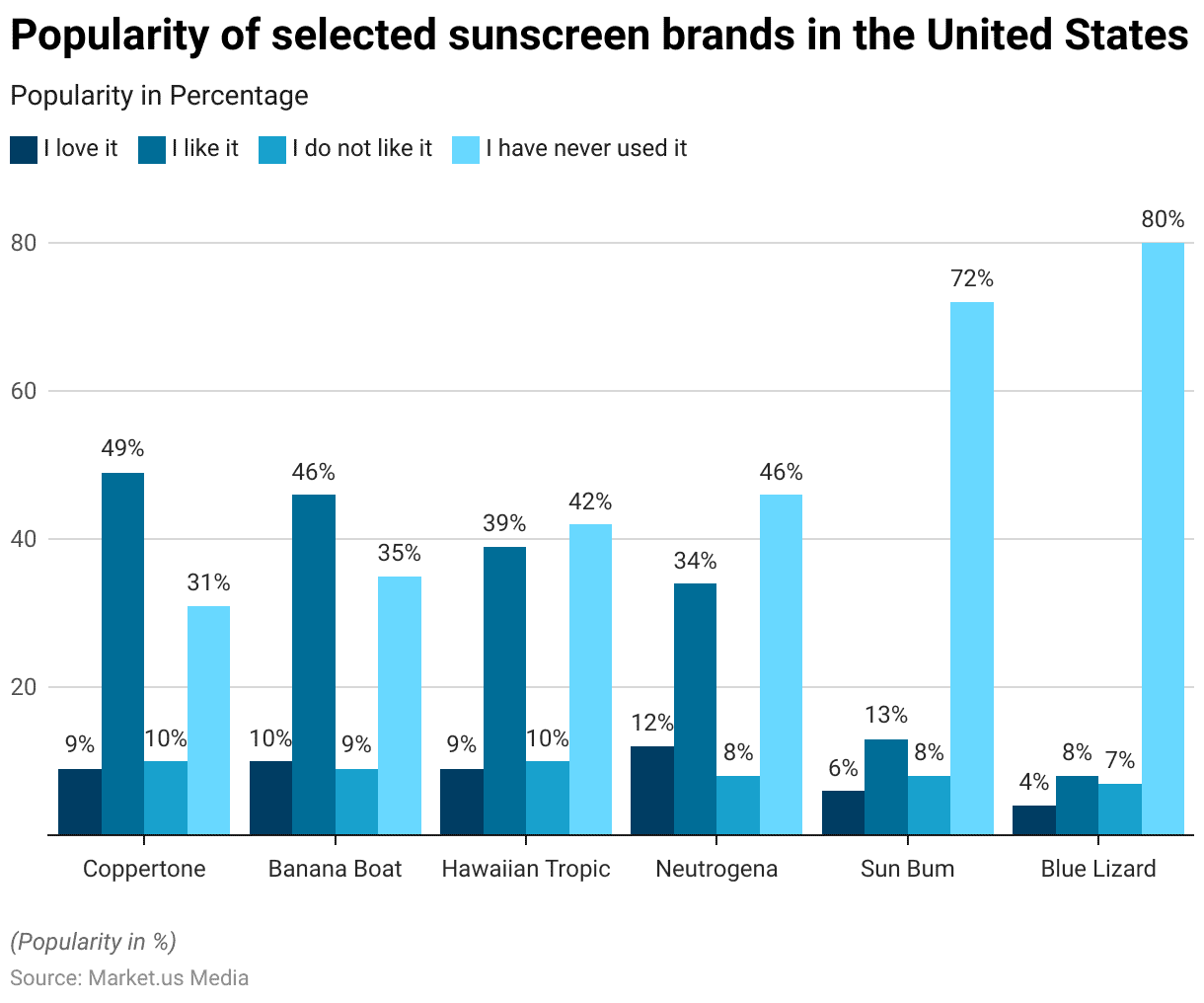
Sunscreen Benefits
- As of March 2024, consumer preferences in China regarding the benefits of sun protection cosmetic products show a clear prioritization of features.
- Moisturizing benefits were the most appealing, valued by 57.80% of respondents. This reflects a high demand for products that can hydrate the skin while offering sun protection.
- Antioxidants were also highly prized, with 52.30% of consumers seeking sun protection products that can combat free radicals and contribute to skin health.
- Soothing properties were important for 47.10% of the respondents. Indicating a preference for products that alleviate skin irritation along with providing UV protection.
- Skin-lightening benefits were desired by 38.10% of those surveyed, and an equal percentage of 31.20% appreciated products that offered brightening effects or isolation—presumably referring to products that create a barrier against environmental pollutants.
- These insights reflect a diverse range of consumer expectations and highlight the importance of multifunctional products in the Chinese market. Where sun protection is integrated with other skincare benefits to meet the broad needs of consumers.
(Source: Statista)
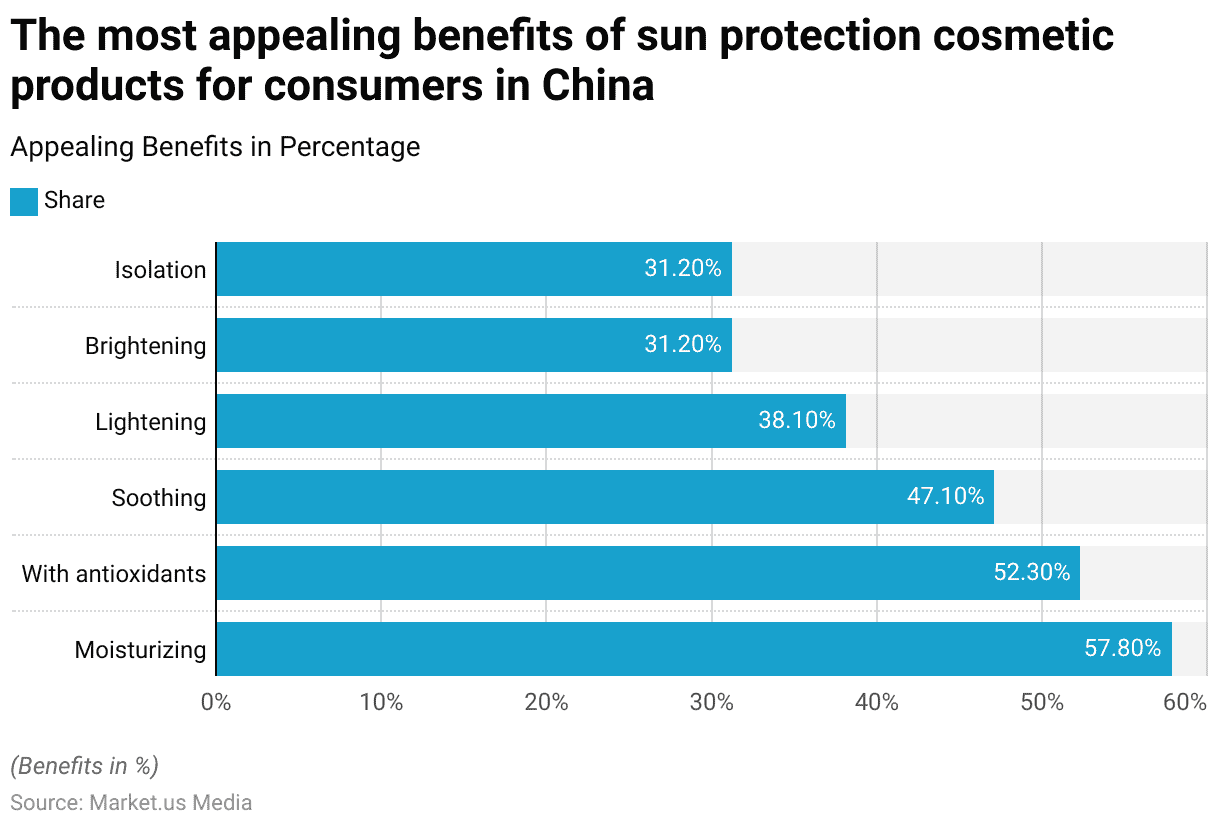
Challenges and Concerns
- In 2022, U.S. consumers showed varied opinions regarding the potential toxicity of traditional sunscreens to their health.
- A minority of 20% believed that traditional sunscreens could be toxic. Indicating concerns about the ingredients commonly used in these products.
- The larger segment, comprising 41% of respondents, did not believe that traditional sunscreens posed any toxicity to their health. Suggesting a level of trust or lack of concern about the compositions of these products.
- Notably, a significant 39% of consumers were unsure, reflecting either a lack of information, awareness, or definitive opinion on the matter.
- This ambiguity highlights a potential area for educational campaigns or further research to address consumer concerns and inform public opinion more clearly about the safety of sunscreen products.
(Source: Statista)
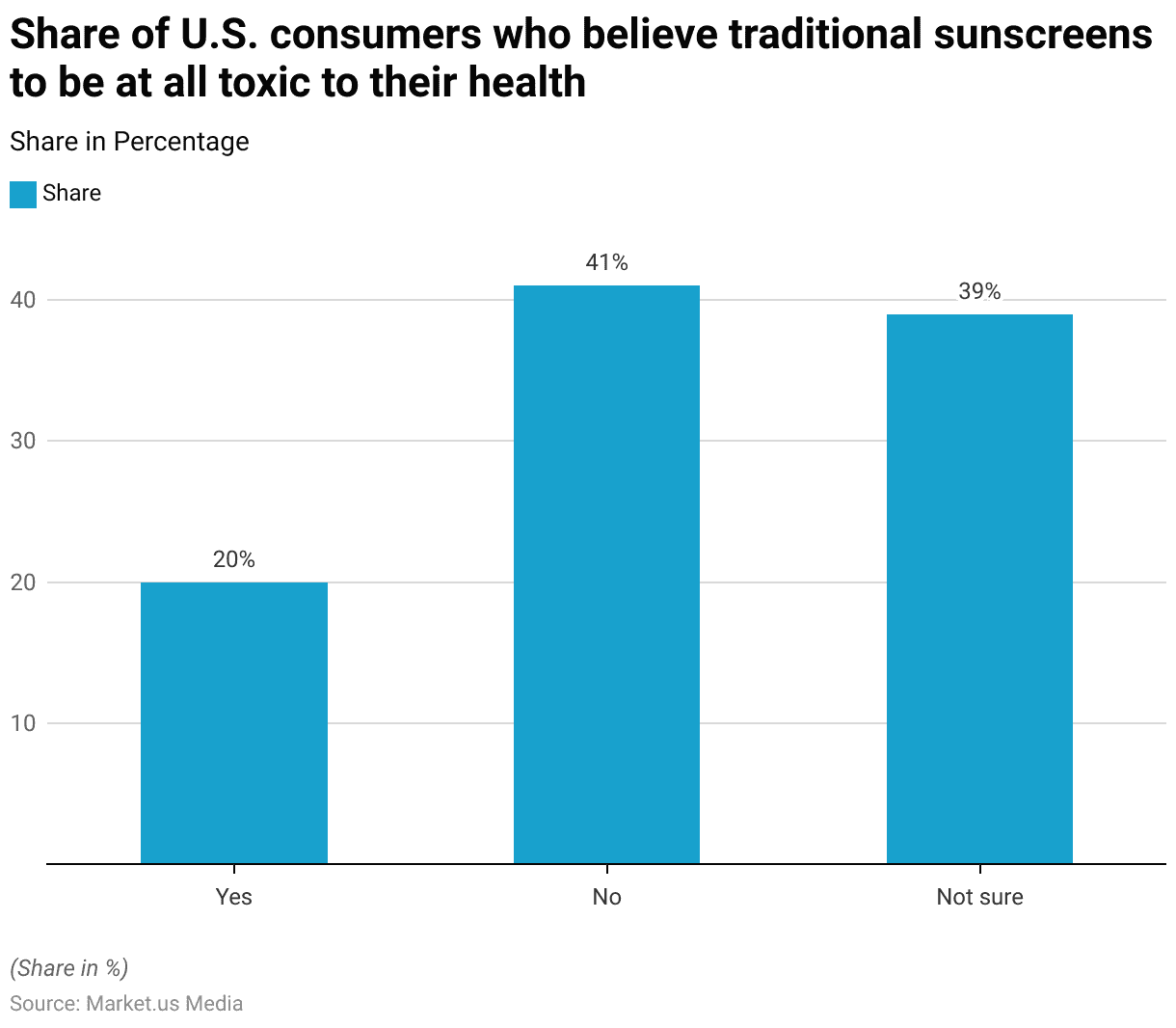
Innovations in Sunscreen Protection Technology
- Recent innovations in sunscreen protection technology have significantly advanced. Focusing on enhancing UV protection and user sensory experience while addressing environmental concerns.
- For instance, L’Oréal has developed a new polymer, AAHCP, that improves sunscreen texture and SPF efficiency without compromising on sensory attributes. This technology, termed Netlock™, creates a uniform, non-oily film on the skin, enhancing water and sweat resistance.
- Simultaneously, BASF introduced Tinomax™ CC, a functionalized natural-based particle that enhances UV protection and sensory feel in sunscreens. This ingredient supports the creation of non-greasy, non-whitening sunscreen formulations and aligns with sustainability goals by being 100% natural-origin content as per ISO 16128.
- Moreover, encapsulated sunscreen technology has emerged as a notable development. Particularly beneficial for sensitive skin due to its ability to minimize direct skin contact with UV filters. Thereby reducing irritation and enhancing cosmetic elegance.
- Unilever has also been active in integrating skincare benefits into its suncare products. Responding to consumer demand for multifunctional products that offer hydration, anti-aging, and brightening effects alongside UV protection.
- Brands like Vaseline and POND’S SKIN INSTITUTE have launched products that combine these skincare benefits with high SPF protection.
- These innovations not only improve the efficacy and user experience of sun protection products but also cater to the growing consumer preference for environmentally responsible and multifunctional skincare solutions.
(Source: cosmeticsdesign.com, BASF, DermLetter, Unilever)
Regulations for Sunscreen Products
- Regulations for sunscreen products vary significantly across countries, reflecting diverse approaches to consumer safety, environmental protection, and market readiness.
- In the United States, sunscreens are treated as over-the-counter drugs with rigorous FDA regulations focusing on SPF, broad-spectrum capabilities, and stringent testing for efficacy and safety.
- In contrast, the European Union categorizes sunscreens as cosmetic products, mandating a minimum UVA protection proportional to their SPF value and stricter labeling requirements.
- Countries like Australia classify sunscreens into therapeutic and cosmetic categories, with a high standard for SPF due to the intense UV exposure levels.
- Canada differentiates sunscreens as natural health products or OTC drugs, each requiring specific labeling and content standards.
- Asia, particularly Japan and South Korea, has unique regulations that consider sunscreens as either cosmetics or quasi-drugs, emphasizing product safety and innovative formulations.
- Environmental concerns also play a role in regulations; regions like Hawaii and Palau restrict sunscreens containing chemicals harmful to coral reefs.
- These diverse regulations necessitate a thorough understanding and strategic compliance efforts for market participants. Underscoring the importance of tailored research to navigate these complex landscapes.
(Sources: Covalo Blog, cosmetics design-europe.com, CEway, Aethic Education)
Recent Developments
Acquisitions and Mergers:
- L’Oréal acquires Thayers Natural Remedies: In 2023, L’Oréal expanded its sun care portfolio by acquiring Thayers Natural Remedies for $400 million. This acquisition aims to integrate natural ingredients into L’Oréal’s sunscreen products. Responding to growing consumer demand for natural and eco-friendly skincare solutions.
- Beiersdorf acquires Coppertone from Bayer: In 2023, Beiersdorf, the parent company of NIVEA, completed the acquisition of Coppertone from Bayer for $550 million. This acquisition enhances Beiersdorf’s sun care division in North America, further solidifying its presence in the global sunscreen market.
New Product Launches:
- Neutrogena introduces Helioplex Ultra: In 2024, Neutrogena launched its new sunscreen line, Helioplex Ultra, which offers enhanced UV protection with a lightweight formula. The product caters to consumers seeking high-SPF sunscreens that are non-greasy and quick-absorbing, aligning with current skincare trends.
- Supergoop! releases mineral-based sunscreen for kids: In late 2023, Supergoop! launched a mineral-based sunscreen specifically designed for children, emphasizing its gentle, chemical-free formula suitable for sensitive skin. This product is expected to meet the increasing demand for natural sun protection for children.
Funding:
- Black Girl Sunscreen raises $10 million for expansion: In 2023, Black Girl Sunscreen, a brand focused on providing sun protection for people of color, secured $10 million in Series A funding. This funding will support product development, marketing, and global expansion, reflecting growing interest in inclusive skincare products.
- Australian brand Sun Bum secures $15 million in funding: In early 2024, Sun Bum, known for its vegan and cruelty-free sunscreens, raised $15 million to expand its product range and enter new international markets. The funding highlights the increased consumer preference for clean and ethical sunscreen products.
Technological Advancements:
- AI-powered skin protection tools: Sunscreen brands are integrating AI technology to help consumers choose the right SPF based on their skin type and UV exposure. By 2025, it is estimated that 20% of sunscreen brands will offer AI-powered mobile apps or online tools to provide personalized sun protection recommendations.
- Eco-friendly sunscreen formulations: Brands are focusing on creating sunscreens with reef-safe and biodegradable ingredients. By 2026, 40% of new sunscreens are expected to be formulated with eco-friendly ingredients, addressing concerns about environmental impact, particularly in coastal areas.
Market Dynamics:
- Growth in the sunscreen market: This growth is driven by rising awareness about skin cancer prevention, increased outdoor recreational activities, and the growing popularity of skincare routines that prioritize sun protection.
- Rising demand for mineral-based sunscreens: The demand for mineral-based sunscreens, particularly those free from harmful chemicals like oxybenzone, is increasing. By 2025, mineral sunscreens are expected to account for 30% of the global market. Reflecting consumer preferences for safer, non-toxic formulations.
Conclusion
Sunscreen Industry Statistics – Sunscreen remains essential for skin health, offering protection against sunburn and reducing skin cancer risks.
Consumer preferences vary widely, with demands for high SPF products that also provide moisturizing and natural ingredients reflecting a trend towards multifunctional, health-conscious products.
However, skepticism about the potential toxicity of traditional sunscreens highlights a need for greater transparency in ingredients to reassure and increase user confidence.
As the market evolves, sunscreen brands must adapt to these trends and ensure their products meet diverse consumer needs while promoting sun safety effectively.
FAQs
Sunscreen is a product that combines several ingredients to help prevent the sun’s ultraviolet (UV) radiation from reaching the skin. Two types of UV radiation, UVA and UVB, can cause skin damage, premature aging, and skin cancers.
Sunscreen products contain filters that either absorb, reflect, or scatter sunlight. Chemical sunscreens absorb UV radiation and convert it into a small amount of heat. Physical sunscreens (containing minerals such as titanium dioxide or zinc oxide) reflect and scatter the radiation.
SPF stands for Sun Protection Factor. It measures how well sunscreen can protect skin from UVB rays, the kind of radiation that causes sunburn, damages skin, and contributes to skin cancer. The number indicates how long UVB rays would take to redden the skin when using the sunscreen as directed compared with the time without sunscreen.
It is recommended that sunscreen be applied in a quantity of about 2 milligrams per square centimeter of skin. For an average adult, this roughly translates to about one ounce (enough to fill a shot glass) to cover the body. Sunscreen should be applied 30 minutes before going outdoors and reapplied approximately every two hours or after swimming, sweating, or towel drying.
Yes, there are sunscreens available for various skin types. For example, individuals with oily skin may prefer water-based or gel-based sunscreens, while those with dry skin may benefit from sunscreens with moisturizers or oil-based compositions. There are also sunscreens formulated for sensitive skin that are free from irritants like fragrances and parabens.
Discuss your needs with our analyst
Please share your requirements with more details so our analyst can check if they can solve your problem(s)



